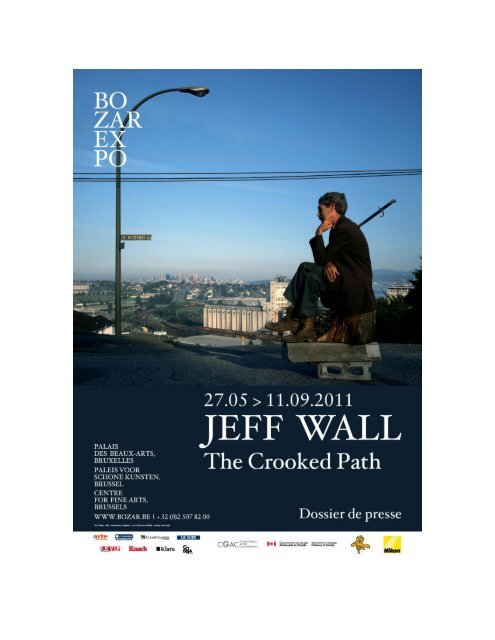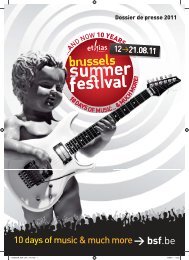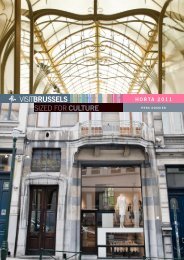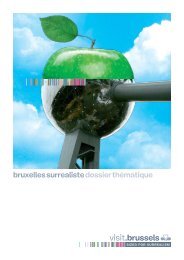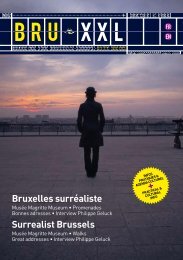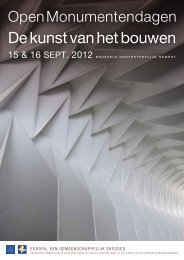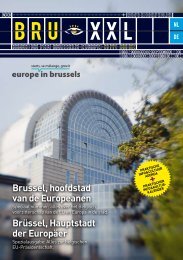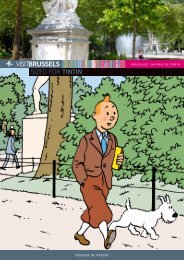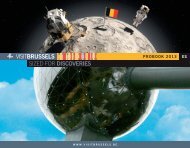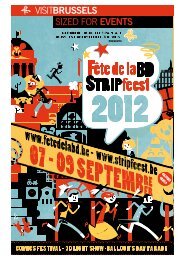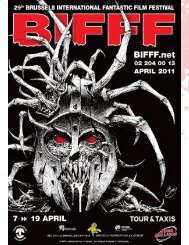Proposition for Jeff Wall exhibition to be held in ... - VisitBrussels
Proposition for Jeff Wall exhibition to be held in ... - VisitBrussels
Proposition for Jeff Wall exhibition to be held in ... - VisitBrussels
Create successful ePaper yourself
Turn your PDF publications into a flip-book with our unique Google optimized e-Paper software.
Table des matièresCommuniqué de presse: <strong>Jeff</strong> <strong>Wall</strong> - The Crooked Path .................................................................. 3The Crooked Path............................................................................................................................ 5From a Crooked Path Towards an Open End ................................................................................. 7Textes des salles ........................................................................................................................... 11Biographie de <strong>Jeff</strong> <strong>Wall</strong> .................................................................................................................. 15Activités complémentaires à l‘exposition ....................................................................................... 17BOZAR LITERATURE .............................................................................................................. 17BOZAR STUDIOS .................................................................................................................... 19In<strong>for</strong>mations pratiques ................................................................................................................... 21Coordonnées du service de presse ............................................................................................... 22Annexe 1 : Centro Galego de Arte Contemporánea ..................................................................... 23Annexe 2 : Liste des œuvres dans l‘exposition ............................................................................. 242
Communiqué de presse: <strong>Jeff</strong> <strong>Wall</strong> - The Crooked Path27.05.2011 - 11.09.2011Le Palais des Beaux-Arts présente The Crooked Path, une exposition du pho<strong>to</strong>graphecanadien <strong>Jeff</strong> <strong>Wall</strong>, dans laquelle l‟artiste établi un dialogue entre ses œuvres et cellesd‟autres grands artistes contempora<strong>in</strong>s comme Marcel Duchamp, Diane Arbus, EugèneAtget, Walker Evans, Frank Stella, Dan Flav<strong>in</strong>, Dan Graham, Carl Andre, Thomas Struth,David Claerbout et Andreas Gurski.<strong>Jeff</strong> <strong>Wall</strong> est sans aucun doute l‘une des personnalités qui a le plus <strong>in</strong>fluencé l'art de ces troisdernieres décennies. En effet, depuis la f<strong>in</strong> des années 1970, l‘artiste canadien, avec sespho<strong>to</strong>graphies de grand <strong>for</strong>mat, exposées dans des caissons lum<strong>in</strong>eux, s‘est attaché à redéf<strong>in</strong>irles paradigmes de la pho<strong>to</strong>graphie. Depuis le début de sa carrière, ses images faisantréférence à l‘his<strong>to</strong>ire de l‘art et plus particulièrement à la pe<strong>in</strong>ture classique, reflètent l‘affirmationd‘une possible cont<strong>in</strong>uité à l'<strong>in</strong>térieur même des canons du modernisme, en y revendiquant lapossibilité « d‘une pe<strong>in</strong>ture de la vie moderne ».L‘exposition The Crooked Path s‘<strong>in</strong>téresse au contexte propice à l‟évolution de l‟œuvre de <strong>Jeff</strong><strong>Wall</strong> et cherche à rendre compte, au travers d'un large choix de ses propres travaux et de ceuxd'autres artistes, d'un parcours au cœur même des préoccupations esthétiques du pho<strong>to</strong>graphe.Le projet exam<strong>in</strong>e en effet les relations étroites que l‟artiste entretient avec son propreprocessus créatif et avec les <strong>in</strong>fluences et les questionnements qui ont marqué celui-ci.Qu‘il s'agisse d'<strong>in</strong>fluences picturales, pho<strong>to</strong>graphiques, c<strong>in</strong>éma<strong>to</strong>graphiques, littéraires,documentaires ou de ses prises de position théoriques, cette exposition cherche à aborder lesgrandes articulations <strong>in</strong>ternes à son travail a<strong>in</strong>si que les expériences esthétiques qui ont orientéses décisions et l'ensemble de son œuvre.Une grande variété de thèmes faisant partie <strong>in</strong>tégrante de l‘œuvre de l‘artiste sont abordéesdans l‘exposition : le m<strong>in</strong>imalisme et la relation à « l‘echelle », la pho<strong>to</strong>graphie his<strong>to</strong>rique, lapho<strong>to</strong>graphie conceptuelle et post-conceptuelle, la littérature, la pho<strong>to</strong>graphie documentaire etbien d‘autres. Pour illustrer ces thèmes, l‘artiste a lui-même choisi v<strong>in</strong>gt-c<strong>in</strong>q de ses œuvres,réalisées entre les années 1970 et aujourd‟hui, <strong>for</strong>mant le corpus central de l‘exposition.Suivant le développement général du concept, ces œuvres seront disposées de façon àengendrer des relations particulières avec un choix d'autres oeuvres sélectionnées par lescommissaires de l'exposition, Joël Benzak<strong>in</strong> et <strong>Jeff</strong> <strong>Wall</strong> en personne. Les œuvres de <strong>Jeff</strong> <strong>Wall</strong>seront en effet presentées en regard d‟œuvres d‟autres artistes his<strong>to</strong>riques et contempora<strong>in</strong>scomme Marcel Duchamp, Diane Arbus, Eugène Atget, Bill Brandt, Walker Evans, Ro<strong>be</strong>rt Frank,Helen Levitt, Wols, He<strong>in</strong>rich Zille, etc., à des artistes plus proches de sa génération comme FrankStella, Bruce Nauman, Dan Flav<strong>in</strong>, Ro<strong>be</strong>rt Smithson, Dan Graham, Douglas Huebler et d‘autres,pour s‘<strong>in</strong>téresser enf<strong>in</strong> à un certa<strong>in</strong> nombre d‘artistes plus jeunes.The Crooked Path offre donc au spectateur un large panorama sur les relations, connections,suggestions et confrontations entre 130 œuvres d‟art. En complicité avec <strong>Jeff</strong> <strong>Wall</strong>, un« dialogue » s‘établira avec des œuvres qui ont de manière directe ou <strong>in</strong>directe <strong>in</strong>fluencé sapratique, constituant a<strong>in</strong>si le contexte propice au développement de sa pensée et aux directionsprises dans son travail, en favorisant une approche qui démontre la complexité et la richesse desa création.A l‘occasion de cette exposition, un important catalogue sera édité, dont le concept orig<strong>in</strong>alconstituera le résultat direct de la « genèse » de l'exposition et reflètera sa structure générale.Sous la direction de l‘his<strong>to</strong>rien d‘art Hans De Wolf, de nombreuses contributions d'ém<strong>in</strong>entsspécialistes viennent enrichir cette publication dont l'objectif consiste à se présenter comme unouvrage novateur dans la littérature consacrée à <strong>Jeff</strong> <strong>Wall</strong>.3
L‘exposition, produite par le Palais des Beaux-Arts de Bruxelles, voyagera en au<strong>to</strong>mne 2011 auCentro Galego de Arte Contemporánea à Sa<strong>in</strong>t-Jacques de Compostelle (Espagne).Section littéraireAprès le succès de la première édition des « Pe<strong>in</strong>tures Parlantes » au<strong>to</strong>ur de Lucas Cranach,avec, notamment, les poèmes de Stefan Hertmans et Astrid Lampe, deBuren et BOZARprésentent une nouvelle série de répliques littéraires aux arts visuels. Six auteurs, <strong>in</strong>spirés par sixpho<strong>to</strong>graphies de <strong>Jeff</strong> <strong>Wall</strong>, ont écrit des his<strong>to</strong>ires courtes donnant vie aux images. Ces textesnarratifs sont disponibles gratuitement en français, néerlandais et anglais dans la section littérairedes audio guides. Les six auteurs sont : Jean Bofane, Bernhard Christiansen, Carol<strong>in</strong>eLamarche, David Nolens, Yves Petry en Chika Unigwe.Commissaire: Joël Benzak<strong>in</strong>Conseiller scientifique et éditeur en chef de la publication: Hans Maria De WolfSoutien: Région de Bruxelles-Capitale, l‟Ambassade du CanadaEn collaboration avec: Centro Galego de Arte Contemporánea, Santiago di CompostelaPartner: ThalysSponsor: Nikon Belux4
The Crooked PathExtrait du catalogue“It‟s a little path made by its users, without a plan, <strong>in</strong> order <strong>to</strong> do someth<strong>in</strong>g that the usualadm<strong>in</strong>istration could not or did not do – so there‟s a slight trace of diso<strong>be</strong>dience or <strong>in</strong>dependence– people may do th<strong>in</strong>gs that we can‟t predict.”<strong>Jeff</strong> <strong>Wall</strong>The sheer quality of <strong>Jeff</strong> <strong>Wall</strong>‘s work – or rather the qualities, so rich is it with new perspectivesand so <strong>in</strong>fluential has it <strong>be</strong>en on the art of the last <strong>for</strong>ty years – is the stimulus <strong>be</strong>h<strong>in</strong>d this<strong>exhibition</strong>. <strong>Wall</strong>‘s work is rich <strong>in</strong> writ<strong>in</strong>gs <strong>to</strong>o, acute observations about his own work and that ofhis <strong>for</strong>erunners and contemporaries. It is rich <strong>to</strong>o <strong>in</strong> <strong>in</strong>terpretations, expressed <strong>in</strong> his images; hiswork opens up new perspectives, constantly push<strong>in</strong>g the boundaries of pho<strong>to</strong>graphicconventions. The hallmark of <strong>Jeff</strong> <strong>Wall</strong>‘s large-<strong>for</strong>mat pho<strong>to</strong>graphs is his use of light boxes whichcreates a c<strong>in</strong>ema<strong>to</strong>graphic effect. Mises en scène of reality, a theatre of everyday life re-enactedby ord<strong>in</strong>ary ac<strong>to</strong>rs, often with a nod <strong>to</strong> pic<strong>to</strong>rial models <strong>in</strong>spired directly by pa<strong>in</strong>t<strong>in</strong>g traditions, hiswork has trans<strong>for</strong>med our traditional concept of pho<strong>to</strong>graphy, break<strong>in</strong>g new ground and creat<strong>in</strong>g aspace <strong>for</strong> condensation where pho<strong>to</strong>graphy, as envisaged by the artist, can claim <strong>for</strong> itself therole of a pa<strong>in</strong>t<strong>in</strong>g of modern life. <strong>Jeff</strong> <strong>Wall</strong> is often descri<strong>be</strong>d as a flâneur – an idle stroller –observ<strong>in</strong>g scenes of daily life, s<strong>in</strong>gl<strong>in</strong>g out characters, attitudes, places and landscapes –elements or ―notes‖ which, after percolat<strong>in</strong>g through his m<strong>in</strong>d, after he has ―dreamed about‖ them,as he descri<strong>be</strong>s it, will <strong>be</strong> used <strong>to</strong> construct his images. This experience of reality, the timeneeded <strong>to</strong> allow the imag<strong>in</strong>ation <strong>to</strong> roam, <strong>to</strong>gether with his profound knowledge of pic<strong>to</strong>rialtradition and his mastery of composition, are what <strong>for</strong>m the richness of his work. Haunted byghosts of a sometimes brusque reality, by remembrances of pa<strong>in</strong>t<strong>in</strong>g, objects, places, and literaryfigures, his works are imbued with a strange <strong>be</strong>auty, creat<strong>in</strong>g this space that lends itself <strong>to</strong> ashared imag<strong>in</strong>ative journey <strong>to</strong> rema<strong>in</strong> as if suspended.This <strong>exhibition</strong> unfolds non-chronologically, <strong>for</strong>eground<strong>in</strong>g subjects that are central <strong>to</strong> the artist‘sexplorations. Each stage is unique, focus<strong>in</strong>g on a selection of <strong>Jeff</strong> <strong>Wall</strong> works and pieces by otherartists. There are ten stations, like chapters <strong>in</strong> a visual narrative, plac<strong>in</strong>g us <strong>be</strong><strong>for</strong>e significantpieces whose purpose is not <strong>to</strong> illustrate a subject but rather <strong>to</strong> express, through the images ondisplay, a special experience – the <strong>Jeff</strong> <strong>Wall</strong> experience.The path <strong>be</strong>g<strong>in</strong>s with reflections relat<strong>in</strong>g <strong>to</strong> <strong>Wall</strong>‘s <strong>in</strong>itial exploration of the physical and mentalspace of the studio, lead<strong>in</strong>g <strong>to</strong> experiments that resulted <strong>in</strong> sem<strong>in</strong>al pieces such as TheDestroyed Room or Picture <strong>for</strong> Woman, presented <strong>in</strong> relation <strong>to</strong> the works of other artists<strong>in</strong>clud<strong>in</strong>g Marcel Duchamp, Bruce Nauman, Chris Burden, Ra<strong>in</strong>er Werner Fassb<strong>in</strong>der, and otherscloser <strong>to</strong> him like Ian <strong>Wall</strong>ace and Rodney Graham. It ends with more recent pho<strong>to</strong>graphs <strong>for</strong>which <strong>Wall</strong> no longer uses the transparent support of cibachrome mounted on a light box. <strong>Jeff</strong><strong>Wall</strong>‘s prime concern was <strong>to</strong> choose pieces <strong>for</strong> their particular importance <strong>to</strong> him and the degree<strong>to</strong> which they resonate with his own work, rather than <strong>to</strong> present a roll-call of major artists andpho<strong>to</strong>graphers.Given the many major retrospectives and monographic <strong>exhibition</strong>s that have <strong>be</strong>en devoted <strong>to</strong> <strong>Jeff</strong><strong>Wall</strong> <strong>in</strong> recent years, we felt that this approach <strong>to</strong> understand<strong>in</strong>g a piece, through a constantdialogue with <strong>Jeff</strong> <strong>Wall</strong>, with space <strong>for</strong> works of his own choice and <strong>for</strong> the relationships he haswith the works of other artists, was the most appropriate. It also reflects a wish <strong>to</strong> place theemphasis on his special rapport with pho<strong>to</strong>graphy, critical <strong>to</strong> <strong>be</strong>g<strong>in</strong> with and then gradually morepeaceful, and <strong>in</strong> particular <strong>to</strong> highlight his role as a l<strong>in</strong>k, re<strong>in</strong>vent<strong>in</strong>g his medium <strong>to</strong> revive abroader pic<strong>to</strong>rial tradition, permitt<strong>in</strong>g a cont<strong>in</strong>uity of the Tableau through images that are bothcomplex and unique.5
The Crooked Path is a picture of <strong>Jeff</strong> <strong>Wall</strong>, the image of a narrow, w<strong>in</strong>d<strong>in</strong>g path cross<strong>in</strong>g awasteland border<strong>in</strong>g an <strong>in</strong>dustrial zone. A fragment of nature neglected by gallop<strong>in</strong>g urbanization,a nebulous terri<strong>to</strong>ry where nature rega<strong>in</strong>s the upper hand <strong>in</strong> an anarchic manner, a terra<strong>in</strong> that<strong>in</strong>vites traffick<strong>in</strong>g, shady deals, a path that tempts us <strong>to</strong> follow it, captures our gaze and offers aperspective…The Crooked Path is also the title of this <strong>exhibition</strong>, its ideal reflection, the narrow,unique passage that <strong>Jeff</strong> <strong>Wall</strong> has carved out <strong>for</strong> himself among the plethora of images.Joël Benzak<strong>in</strong>, commissaire de l‟exposition6
From a Crooked Path Towards an Open EndExtrait du catalogueThe unique quality of the project presented here lies <strong>in</strong> the fact that this attempt at acomprehensive understand<strong>in</strong>g of <strong>Jeff</strong> <strong>Wall</strong>‘s oeuvre <strong>in</strong> light of its his<strong>to</strong>rical significance <strong>to</strong>day has<strong>be</strong>en made <strong>in</strong> close collaboration with the artist himself – comb<strong>in</strong><strong>in</strong>g exist<strong>in</strong>g theoreticalframeworks with very personal – not <strong>to</strong> say purely subjective – po<strong>in</strong>ts of emphasis <strong>to</strong> arrive at aunique <strong>exhibition</strong>, which opens with a picture of a small landscape by the artist, called TheCrooked Path.But how <strong>to</strong> translate the a<strong>for</strong>ementioned ambitious <strong>in</strong>tentions <strong>in</strong><strong>to</strong> a sister publication? From theoutset, it was clear <strong>to</strong> me that a traditional catalogue <strong>for</strong>mat would not <strong>be</strong> sufficient <strong>for</strong> the taskahead. For this reason, I devised an organization <strong>in</strong><strong>to</strong> chapters, centered on <strong>in</strong>terviews andentrées, that aims <strong>to</strong> cover as accurately as possible the ske<strong>in</strong> of op<strong>in</strong>ions, reflections, his<strong>to</strong>ricalfacts, images and artworks from a variety of backgrounds and periods that is the present<strong>exhibition</strong>. Even here the crooked path functions as a perfect metaphor: however orig<strong>in</strong>al thenewly developed <strong>for</strong>mat may <strong>be</strong>, it also <strong>in</strong> itself illustrates that no book scheme will ever capturethe complexity of <strong>Jeff</strong> <strong>Wall</strong>‘s endeavour as an artist. Even when, as an edi<strong>to</strong>r, you can rely on thecommitment of over thirty excellent contribu<strong>to</strong>rs who are all acqua<strong>in</strong>ted with <strong>Jeff</strong>‘s work throughdifferent experiences, you unavoidably end with a new overall picture of the oeuvre that onlyapproaches what constitutes the heart of its artistic essence. To work your way around theoeuvre seems <strong>to</strong> <strong>be</strong> the only option; you can take many directions, and you are free <strong>to</strong> follow ornot <strong>to</strong> follow the crooked path.This <strong>in</strong>troduction will not dwell on what follows <strong>in</strong> the book, as I <strong>be</strong>lieve it would <strong>be</strong> much more<strong>in</strong>terest<strong>in</strong>g <strong>to</strong> familiarize the reader with a num<strong>be</strong>r of analytical models that will allow him or her <strong>to</strong>move freely and with deeper understand<strong>in</strong>g across the different chapters. Let‘s start with a modelnamed after a famous Japanese movie.The “Rashomon model”In his 1950 masterpiece Rashomon, the Japanese c<strong>in</strong>easte Akira Kurosawa unfolds the simples<strong>to</strong>ry of how a samurai, travell<strong>in</strong>g with his wife on horseback, is trapped <strong>in</strong> an ambush by ano<strong>to</strong>rious bandit. Tied <strong>to</strong> a tree, the man is <strong>for</strong>ced <strong>to</strong> witness his wife‘s violation and he iseventually murdered. Kurosawa famously set the action <strong>in</strong> a court context, which allowed him <strong>to</strong>relate the narrative from four different po<strong>in</strong>ts of view, one <strong>for</strong> each of the film‘s ma<strong>in</strong> characters, <strong>in</strong>addition <strong>to</strong> the (so <strong>to</strong> speak) neutral perspective of a lum<strong>be</strong>rjack, who takes on the role of theobliga<strong>to</strong>ry bystander. The result is as<strong>to</strong>nish<strong>in</strong>g. The events are quickly <strong>to</strong>ld and are the same <strong>for</strong>all four of the characters. Beyond those mere facts the specta<strong>to</strong>r, however, loses any grip on thesituation <strong>be</strong>cause all the narratives constantly contradict each other.Our understand<strong>in</strong>g of reality is suddenly replaced by another model, based on the coexistence ofprobabilities and narrative structures that cross each other <strong>in</strong> their complexity. It is a model thatdoes not come with the need <strong>to</strong> stick <strong>to</strong> an absolute truth. This notion of the truth, however, is notabandoned either <strong>be</strong>cause it is replaced by the realization that, <strong>to</strong>gether, the coexistence of thesedifferent versions <strong>for</strong>ms a more or less complete understand<strong>in</strong>g of what is at stake, and certa<strong>in</strong>lya more <strong>in</strong>terest<strong>in</strong>g one. I there<strong>for</strong>e suggest we relate the fundamental motivation of this <strong>Jeff</strong> <strong>Wall</strong>project <strong>to</strong> four similar l<strong>in</strong>es of understand<strong>in</strong>g, essentially <strong>in</strong>tertw<strong>in</strong>ed. They operate and relate <strong>to</strong>each other accord<strong>in</strong>g <strong>to</strong> a very similar model, fuelled by energies of negation and attraction, and<strong>to</strong>gether they are more or less complete.Without any pretention whatsoever that this selection of four is an exhaustive one (otherspecta<strong>to</strong>rs might come up with other comb<strong>in</strong>ations), I selected the follow<strong>in</strong>g four l<strong>in</strong>es ofunderstand<strong>in</strong>g.7
First: this project reflects on the relations <strong>be</strong>tween <strong>Jeff</strong> <strong>Wall</strong>‘s oeuvre and notions of pho<strong>to</strong>graphy,from the archaic medium pr<strong>in</strong>ciples, via classical pho<strong>to</strong>graphy from the early days, <strong>to</strong> thesophisticated applications of younger colleagues <strong>to</strong>day. It takes up the his<strong>to</strong>rical establishment ofpho<strong>to</strong>graphy as a major medium <strong>in</strong> the visual arts, a change <strong>in</strong> perception <strong>in</strong> which <strong>Jeff</strong> <strong>Wall</strong> hasplayed a major role.Second: the present project can <strong>be</strong> unders<strong>to</strong>od as a call <strong>for</strong> an attitude that celebrates<strong>in</strong>clusiveness and openness <strong>in</strong> the connections <strong>be</strong>tween the major canonical art <strong>for</strong>ms. Each ofthem, however, still represents an au<strong>to</strong>nomous body of qualities dist<strong>in</strong>ctive of the separate art<strong>for</strong>ms that cannot <strong>be</strong> dismissed. This idea lies at the heart of <strong>Wall</strong>‘s trenchant critique of certa<strong>in</strong>practices of the Avant-gardes of the 1960s and later, such as Conceptual Art. He understandstheir <strong>in</strong>sistence on the possibility of a tabula rasa as a start<strong>in</strong>g-po<strong>in</strong>t <strong>for</strong> someth<strong>in</strong>g new, as a markof exclusiveness.Third: this project defends, <strong>in</strong> a variety of ways, the premise that all great art essentially takes itsimportance and his<strong>to</strong>rical cont<strong>in</strong>uity from its au<strong>to</strong>nomy. In <strong>Wall</strong>‘s own enterprise, this need <strong>for</strong>au<strong>to</strong>nomy takes shape <strong>in</strong> a personal theory that expla<strong>in</strong>s the relation <strong>be</strong>tween the au<strong>to</strong>nomy ofthe picture and the creative act that br<strong>in</strong>gs it <strong>in</strong><strong>to</strong> existence. ―Near Documentary‖, as <strong>Wall</strong> calls it,conveys that every great artwork is a construction that hopes <strong>to</strong> <strong>be</strong> experienced as someth<strong>in</strong>gtruthful, and at the same time expects <strong>to</strong> <strong>be</strong> revealed as artifice. (1)Fourth: <strong>in</strong> the last l<strong>in</strong>e of understand<strong>in</strong>g, this project stresses that all great art is <strong>in</strong> pr<strong>in</strong>ciple part of– and a response <strong>to</strong> – a greater, cyclical understand<strong>in</strong>g of the his<strong>to</strong>ry of the arts, as KarlSchnaase would have called this. (2) This his<strong>to</strong>rical component should not <strong>be</strong> misunders<strong>to</strong>od <strong>for</strong>a sort of chronological order. <strong>Jeff</strong> <strong>Wall</strong> understands his relation <strong>to</strong> figurative art of the classicalAvant-gardes (from Matisse <strong>to</strong> the Neue Sachlichkeit and later) as a cont<strong>in</strong>u<strong>in</strong>g dialogue that still<strong>to</strong>day holds relevance. At the same time, this approach <strong>to</strong> art his<strong>to</strong>ry as an open, dynamic <strong>for</strong>ceallows us <strong>to</strong> understand the development of the medium of pho<strong>to</strong>graphy <strong>be</strong>tween the late 1960sand the 1990s as an important his<strong>to</strong>rical achievement <strong>in</strong> itself, lead<strong>in</strong>g <strong>to</strong> a strong affirmation of itslegitimate place <strong>in</strong> the realm of the visual arts.This ―Rashomon model‖ can <strong>be</strong> a <strong>to</strong>ol <strong>in</strong> understand<strong>in</strong>g how the different chapters of the book are<strong>in</strong>tertw<strong>in</strong>ed. As a whole, it addresses the legitimate set of questions that every serious andcomprehensive art project calls up: what place will the project hold <strong>in</strong> future generations‘memory? What will its <strong>in</strong>fluence <strong>be</strong> over the chapters of art his<strong>to</strong>ry <strong>to</strong> <strong>be</strong> written? Where will theproject surface <strong>in</strong> the canon of the visual arts as future generations shape that canon?The “Mallarméan model”This model, which takes its name from the famous French symbolic poet heavily <strong>in</strong>fluential <strong>in</strong> thehis<strong>to</strong>rical Avant-gardes from the late 19 th and early 20 th centuries, addresses the generic natureof the artwork and the space of the artist <strong>in</strong> the creative act. In his theoretical writ<strong>in</strong>gs, Mallarméstresses that the persona of the artist is often characterized by an un<strong>be</strong>arable aura ofconceitedness (<strong>in</strong>herited from Romanticism) that <strong>in</strong>evitably leads <strong>to</strong> <strong>in</strong>ner confusion. In his view,the artist‘s role is much less the expression of an attitude and has a much more noble character.He considers it a comb<strong>in</strong>ation of two conditions. On the one hand, he places the gifted medium(the qu<strong>in</strong>tessential body of consciousness) who suddenly understands (par un éclat) the <strong>for</strong>m ofthe artwork and the absolute need <strong>for</strong> it. This <strong>in</strong>itial given, which Mallarmé repeatedly relates <strong>to</strong> a―constellation‖, is then completed by a second understand<strong>in</strong>g of the artist as a dogged craftsmanwho realizes with pa<strong>in</strong>stak<strong>in</strong>g ef<strong>for</strong>t, as closely as possible, his <strong>in</strong>itial conception of the artwork.This part of the creative process calls <strong>for</strong> specific, medium-related skills, experience and métier,and the presence of a varied body of knowledge that can enrich the project.(3)8
A second Mallarmé-related motive br<strong>in</strong>gs <strong>in</strong> the figure of the specta<strong>to</strong>r and serves as acounterpart <strong>to</strong> the first one. In fact, the specta<strong>to</strong>r can only appreciate the artwork if he comes <strong>in</strong><strong>to</strong>direct contact with the materialized <strong>for</strong>m of the artist‘s <strong>in</strong>itial idea. But when is this so? To thesame extent that the artist ultimately has no access <strong>to</strong> the purely conceptual idea that lies at thebasis of the artwork, the specta<strong>to</strong>r can never access that essentially abstract realm. However, ifhis <strong>in</strong>terest <strong>in</strong> the material <strong>for</strong>m of the artwork is genu<strong>in</strong>e, a variety of ―illum<strong>in</strong>ated‖ sub-ideas canshed light on the artwork <strong>for</strong> the specta<strong>to</strong>r. Sub-ideas are by def<strong>in</strong>ition related <strong>to</strong> the <strong>in</strong>itialabstraction they stem from and are equal <strong>in</strong> their diversity. This Mallarméan model helps us <strong>to</strong>expla<strong>in</strong> why <strong>Jeff</strong> <strong>Wall</strong>‘s work has received such a prolific and varied critical <strong>for</strong>tune, and still does<strong>to</strong>day. The majority of the approaches, <strong>in</strong>terpretations and critiques dedicated <strong>to</strong> his work are thefruits of such an <strong>in</strong>-depth critical labour.The catalogue‘s structure, <strong>in</strong> comb<strong>in</strong><strong>in</strong>g dialogues with citations and a myriad of entries by verydifferent authors, is a direct response <strong>to</strong> this central idea of the Mallarméan constellation, thishigher mental order that atta<strong>in</strong>s its deepest significance <strong>in</strong> cont<strong>in</strong>ually connect<strong>in</strong>g related sourcesof knowledge and <strong>in</strong>sights.The “Medium model”A third issue that needs address<strong>in</strong>g is the notion of medium. <strong>Jeff</strong> <strong>Wall</strong>‘s oeuvre can well <strong>be</strong>considered a s<strong>in</strong>gle, ongo<strong>in</strong>g artist‘s reflection on the chang<strong>in</strong>g conditions of his medium:pho<strong>to</strong>graphy. In us<strong>in</strong>g such a generic term, we have <strong>to</strong> rema<strong>in</strong> alert <strong>be</strong>cause the word ―medium‖,when applied <strong>to</strong> the arts, functions as a l<strong>in</strong>guistic ―shifter‖: it only receives its significance from thecontext <strong>in</strong> which it is used. And even so, one can impossibly pretend that the medium ofpho<strong>to</strong>graphy is def<strong>in</strong>ed by the equipment needed and the techniques applied <strong>in</strong> the production ofa picture. Stay<strong>in</strong>g clear here from a more fundamental debate, we might <strong>for</strong> the time <strong>be</strong><strong>in</strong>g def<strong>in</strong>e―medium‖ as an ―<strong>in</strong>strumentalizer‖ that operates <strong>in</strong> <strong>be</strong>tween the notion of métier and the creationof art.On another level, where the notion of the medium can <strong>be</strong> unders<strong>to</strong>od <strong>in</strong> its his<strong>to</strong>ricalconsequences, we could dist<strong>in</strong>guish <strong>be</strong>tween a medium that has <strong>be</strong>en stable <strong>in</strong> its development<strong>for</strong> ages – pa<strong>in</strong>t<strong>in</strong>g, <strong>for</strong> <strong>in</strong>stance – and a medium like pho<strong>to</strong>graphy that has gone through majorparadigmatic shifts over the last decades, slowly acquir<strong>in</strong>g a more stable, def<strong>in</strong>ite shape. In all thestages of his development as an artist, <strong>Jeff</strong> <strong>Wall</strong> has <strong>be</strong>en driven by a desire <strong>to</strong> make a significantcontribution <strong>to</strong> the affirmationof his medium <strong>in</strong> its canonical relation <strong>to</strong> other visual arts. And nowhere <strong>in</strong> his œuvre is this idea –that spr<strong>in</strong>gs up <strong>in</strong> this <strong>exhibition</strong> as a leitmotif – so delightfully developed as <strong>in</strong> a Certa<strong>in</strong> Gust ofW<strong>in</strong>d.<strong>Jeff</strong> <strong>Wall</strong> stages this large-scale pho<strong>to</strong>graph, conceived as a ―remake‖ of a situation depicted <strong>in</strong> apr<strong>in</strong>t by the famous Japanese master Hokusai, <strong>in</strong> 1993, some 160 years after it was first pr<strong>in</strong>ted.If we compare it <strong>to</strong> the orig<strong>in</strong>al copy, we are amazed <strong>to</strong> see how m<strong>in</strong>utely <strong>Wall</strong> has reconstructeda scene that <strong>in</strong> fact amounted <strong>to</strong> pure chance: under the pull of a ―sudden gust of w<strong>in</strong>d‖, one ofthe figures <strong>in</strong> the open suburban landscape lets go of a pile of papers that the w<strong>in</strong>d blows away.In <strong>Wall</strong>‘s pic<strong>to</strong>rial grammar, this picture can <strong>be</strong> read as a qu<strong>in</strong>tessential example of the artist‘sunderstand<strong>in</strong>g of pho<strong>to</strong>graphy as a <strong>for</strong>m of c<strong>in</strong>ema<strong>to</strong>graphy. On a deeper level, however,someth<strong>in</strong>g else appears <strong>to</strong> <strong>be</strong> at stake here.Just like his somewhat older colleague Utamaro, Hokusai built his last<strong>in</strong>g reputation on his skilledpractice of Ukiyo-e, Japanese woodblock pr<strong>in</strong>t<strong>in</strong>g. In late 18th-century Japan, this medium wasconsidered a popular art <strong>for</strong>m – wholly dist<strong>in</strong>ct from traditional Japanese pa<strong>in</strong>t<strong>in</strong>g and sculpture –that gave dar<strong>in</strong>g evidence of a remarkable sense of li<strong>be</strong>rty and spatial audacity <strong>in</strong> its depiction ofscenes of everyday life <strong>in</strong> a <strong>to</strong>wn‘s popular neighbourhoods. Although what rema<strong>in</strong>s fasc<strong>in</strong>at<strong>in</strong>g isthe extent <strong>to</strong> which the conditions <strong>for</strong> approach<strong>in</strong>g traditional environments <strong>in</strong> a novel manner9
seemed closely related <strong>to</strong> the medium of Ukiyo-e as such. At the same time, each of these<strong>be</strong>autiful pr<strong>in</strong>ts is one that has <strong>be</strong>en meticulously constructed.At this po<strong>in</strong>t, it <strong>be</strong>comes difficult not <strong>to</strong> see the similarities with <strong>Jeff</strong> <strong>Wall</strong>‘s position as an artist of adifferent century, work<strong>in</strong>g <strong>in</strong> a medium of multiplication (though he refuses <strong>to</strong> see it as such), witha personal faith <strong>in</strong> the absolute power of that medium, <strong>to</strong> such an extent that he can make hispo<strong>in</strong>t by shoot<strong>in</strong>g a remak<strong>in</strong>g of a Japanese pr<strong>in</strong>t that most likely came <strong>to</strong> him as an isolatedimage pr<strong>in</strong>ted <strong>in</strong> a book of a by-now famous Japanese artist. I cannot th<strong>in</strong>k of a more <strong>to</strong>uch<strong>in</strong>gway <strong>to</strong> pay homage <strong>to</strong> such an important artist – other than by los<strong>in</strong>g his connection with theaspect of multiplication. (4) But <strong>in</strong> this act, <strong>in</strong>evitably, someth<strong>in</strong>g was lost – the only timelesselement <strong>in</strong> Hokusai‘s pr<strong>in</strong>t, the Fuji mounta<strong>in</strong>.“The catalogue” modelTo conclude, I would like <strong>to</strong> address the creation of this catalogue as a model <strong>in</strong> itself. At the timewe started work<strong>in</strong>g on this project three years ago, we were not immediately th<strong>in</strong>k<strong>in</strong>g about aparticular catalogue model <strong>in</strong> the many <strong>in</strong>-depth conversations we had with <strong>Jeff</strong> <strong>Wall</strong> <strong>in</strong> his studio<strong>in</strong> Vancouver. But the more the unusual organization of the <strong>exhibition</strong> <strong>to</strong>ok shape, the more Iunders<strong>to</strong>od that a traditional catalogue would not <strong>be</strong> able <strong>to</strong> render and measure up <strong>to</strong> the highambitions of the <strong>exhibition</strong>. So I suggested a shift away from a structure <strong>in</strong> which a central sourceof knowledge dom<strong>in</strong>ates <strong>in</strong> the <strong>for</strong>m of one or several authors, <strong>to</strong>wards a model that celebrates ageodesic community of knowledge, one that could accommodate as many voices as there werecorrespond<strong>in</strong>g issues <strong>to</strong> which they could <strong>be</strong> related.Presently structured <strong>in</strong><strong>to</strong> a clear sequence of chapters; it br<strong>in</strong>gs <strong>to</strong>gether ideas, thoughts and<strong>in</strong>sights (like pieces <strong>in</strong> a puzzle) <strong>to</strong> produce a new global picture. With this difference: that thef<strong>in</strong>al puzzle picture we have ended with was wholly unpredictable. From this po<strong>in</strong>t of view, thecatalogue can <strong>be</strong> read as a dynamic, <strong>in</strong>tellectual companion <strong>to</strong> the <strong>exhibition</strong>, as a guide as wellas a different source of experience that br<strong>in</strong>gs <strong>for</strong>th novel thoughts and questions – much like <strong>Jeff</strong><strong>Wall</strong> <strong>be</strong>lieves art should work: as an open and ongo<strong>in</strong>g debate <strong>be</strong>tween past and future, as anever-end<strong>in</strong>g and, more importantly, open-ended <strong>in</strong>quiry.Hans De Wolf, conseiller scientifique et éditeur en chef de la publication(1) When deal<strong>in</strong>g with the relation <strong>be</strong>tween the creative act and nature, Kant, <strong>in</strong> his Critique ofJudgement, comes <strong>to</strong> a conclusion that is very similar <strong>to</strong> <strong>Jeff</strong> <strong>Wall</strong>‘s understand<strong>in</strong>g of ―NearDocumentary‖. Together with two other citations, a mean<strong>in</strong>gful excerpt of this theory opens thiscatalogue.(2) Karl Schnaase, a student of Hegel, unders<strong>to</strong>od the notion of evolution <strong>in</strong> art not as a dialecticalprocess, chronologically directed <strong>to</strong>wards the future, but as an ongo<strong>in</strong>g cyclical cont<strong>in</strong>uity of ideas,<strong>held</strong> <strong>in</strong> periods that enlighten each other. He called it a ―synoptic view‖. This could expla<strong>in</strong> whyideas from one period can <strong>be</strong> experienced as mean<strong>in</strong>gful or not <strong>in</strong> another period. Michael Podro,The Critical His<strong>to</strong>rians of Art (New Haven and London: Yale University Press, 1982), 31–42.(3) Mallarmé developed those ideas <strong>in</strong> a collection of thoughts and reflections called ―Variations sur unsujet‖. Stéphane Mallarmé, OEuvres complètes (Paris: Gallimard (Bibliothèque de la Pléiade),1992), 353–68. For citations <strong>in</strong> English <strong>in</strong> this publication we refer <strong>to</strong> Mallarmé, Selected ProsePoems, Essays, & Letters (Baltimore: The Johns Hopk<strong>in</strong>s Press, 1956).(4) <strong>Jeff</strong> <strong>Wall</strong>‘s understand<strong>in</strong>g of the notion of reproduction as related <strong>to</strong> pho<strong>to</strong>graphy <strong>for</strong>ms the ma<strong>in</strong>argument of the <strong>in</strong>troduction <strong>to</strong> chapter 10 of this publication, titled: The Unique and its Properties.10
Textes des sallesDepuis 1978, les « tableaux pho<strong>to</strong>graphiques » de <strong>Jeff</strong> <strong>Wall</strong> ont été caractérisés par l‘utilisationde caissons lum<strong>in</strong>eux qui confèrent à ses grandes images un aspect c<strong>in</strong>éma<strong>to</strong>graphique. Misesen scènes de la réalité, théâtre de la vie ord<strong>in</strong>aire rejoué par des acteurs ord<strong>in</strong>aires, faisantsouvent référence a des modèles picturaux directement <strong>in</strong>spirés de l‘his<strong>to</strong>ire de la pe<strong>in</strong>ture, sesœuvres ont trans<strong>for</strong>mé l‘idée que nous avions de la pho<strong>to</strong>graphie pour en faire un espace decondensation où celle-ci pourrait reprendre à son compte le programme d‘une pe<strong>in</strong>ture de la viemoderne.Dans cette exposition se déploie un parcours non chronologique mettant en avant les grandssujets au centre des préoccupations de l‘artiste. Chacune des étapes proposées au public a sas<strong>in</strong>gularité et s‘articule au<strong>to</strong>ur d‘un choix d‘œuvres de <strong>Jeff</strong> <strong>Wall</strong> et de celles d‘autres artistes. Endix stations, comme autant de chapitres d‘un récit visuel nous sommes mis en présenced‘œuvres significatives qui n‘ont pas pour but d‘illustrer un propos mais plutôt de dess<strong>in</strong>er uncontexte, de situer le travail d‘un artiste dans un ensemble plus large et d‘<strong>in</strong>viter le public, autravers des images proposées, a partager une expérience spécifique, celle de <strong>Jeff</strong> <strong>Wall</strong>.Cette manière d‘appréhender une œuvre, au travers d‘un dialogue constant avec <strong>Jeff</strong> <strong>Wall</strong>, enlaissant place à ses propres choix et aux relations qu‘il entretient avec les œuvres d‘autresartistes, nous semble la plus pert<strong>in</strong>ente en regard des nombreuses grandes expositionsrétrospectives ou monographiques qui lui ont été consacrées ces dernières années. Cetteapproche correspond aussi à la volonté de mettre l‘accent sur son rapport particulier à lapho<strong>to</strong>graphie, d‘abord critique puis peu à peu « pacifié », mais aussi et sur<strong>to</strong>ut sur son rôle depasseur, ré<strong>in</strong>ventant son medium pour renouer avec une tradition picturale plus large et y trouverla possibilité d‘une cont<strong>in</strong>uité du Tableau au travers d‘images à la fois complexes et s<strong>in</strong>gulières.The Crooked Path est une pho<strong>to</strong>graphie de <strong>Jeff</strong> <strong>Wall</strong>, elle représente un petit sentier s<strong>in</strong>ueuxtraversant un terra<strong>in</strong> en friche, à la bordure d‘une zone <strong>in</strong>dustrielle. Un morceau de nature laissépour compte d‘une urbanisation galopante, un terri<strong>to</strong>ire <strong>in</strong>décis où la nature regagne ses droits demanière anarchique, un terra<strong>in</strong> propice aux échanges clandest<strong>in</strong>s, un chem<strong>in</strong> qui <strong>in</strong>vite à latraversée, capte le regard et propose une perspective… The Crooked Path est aussi le titre decette exposition, son meilleur reflet, ce passage étroit et unique que <strong>Jeff</strong> <strong>Wall</strong> a su s‘ouvrir dans lamultitude des images.1. Années 1970Dans cette pièce, sont exposés quelques-uns des premiers transparents de <strong>Jeff</strong> <strong>Wall</strong>, créés à laf<strong>in</strong> des années 1970, a<strong>in</strong>si qu‘ une sélection d‘œuvres d‘autres artistes qui l‘ont <strong>in</strong>fluencé dansl‘élaboration du po<strong>in</strong>t de départ pour le nouveau genre de pho<strong>to</strong>graphies qu‘il a commencé à faireà ce moment-là. On y retrouve pho<strong>to</strong>graphies, œuvres littéraires, films, per<strong>for</strong>mances etsculptures, qui montrent bien la complexité des orig<strong>in</strong>es du travail de <strong>Jeff</strong> <strong>Wall</strong> et, par extension,de <strong>to</strong>ute œuvre artistique.2. Format et m<strong>in</strong>imalisme<strong>Jeff</strong> <strong>Wall</strong> a <strong>to</strong>ujours <strong>in</strong>sisté que ses idées sur la taille et le <strong>for</strong>mat de ses pho<strong>to</strong>s ont puisé leurorig<strong>in</strong>e dans la pe<strong>in</strong>ture et la sculpture de différentes périodes, mais plus particulièrement danscelles des années 1960. Cette pièce accueille des œuvres de quatre artistes m<strong>in</strong>imalistes etpost-m<strong>in</strong>imalistes dont les créations ont eu une importance particulière sur l‘évolution du travailde <strong>Jeff</strong> <strong>Wall</strong>, <strong>to</strong>ut comme sur une de ses plus grandes œuvres, The S<strong>to</strong>ryteller, créée en 1986.« J‟ai grandi en regardant les pe<strong>in</strong>tures de Pollock, de Koon<strong>in</strong>g, Kl<strong>in</strong>e, Newman etRothko, et leur travail m‟a fasc<strong>in</strong>é en raison de sa grandeur. Ce n‟était pas uniquement lataille des pe<strong>in</strong>tures, c‟était aussi la manière emphatique d‟<strong>in</strong>terpeller le spectateur, dans11
laquelle j‟ai vu une manière de s‟<strong>in</strong>terpeller soi-même, de se lancer un propre défi. Legroupe d‟artistes new-yorkais suivants – Stella, Andre, Judd et les autres – onttrans<strong>for</strong>mé cette grandeur en quelque chose de plus matériel et plus immédiat. Ils ont ôtécette <strong>in</strong>tériorité, si importante chez les expressionnistes abstraits; je n‟aime pas<strong>be</strong>aucoup cette <strong>in</strong>itiative, mais le résultat artistique était quand même <strong>in</strong>téressant. Et c‟estpeut-être en partie cette extériorisation qui rapproche des aspects de l‟art m<strong>in</strong>imaliste àl‟ambiance pho<strong>to</strong>graphique. Dans <strong>to</strong>us les cas, je sais que l‟<strong>in</strong>térêt que je porte à lareprésentation grandeur nature vient d‟une part de Pollock, Stella et les autres et d‟autrepart de la pe<strong>in</strong>ture figurative, dans la tradition de Velázquez et Manet. Si l‟on voit celad‟un po<strong>in</strong>t de vue <strong>in</strong>tellectuel ou purement de l‟his<strong>to</strong>ire de l‟art, cela peut sembler étrangeet au<strong>to</strong>contradic<strong>to</strong>ire, mais ce n‟est pas mon avis. Ou alors, si c'est effectivementau<strong>to</strong>contradic<strong>to</strong>ire, ça doit être positif. »<strong>Jeff</strong> <strong>Wall</strong>. The Crooked Path, catalogue d‘exposition, Bruxelles, 20113. C<strong>in</strong>éma<strong>to</strong>graphie<strong>Jeff</strong> <strong>Wall</strong> a souvent parlé de son travail en lui appliquant l‘adjectif de « c<strong>in</strong>éma<strong>to</strong>graphique »,dans le sens où la présentation de ses images, leur mise en scène, leur qualité de lumière etleur taille, entretiennent de nombreuses similitudes avec le 7eme art. Pour lui, le c<strong>in</strong>éma est lasynthèse de trois fonctions : la pe<strong>in</strong>ture, le théâtre et la technique de la reproductionpho<strong>to</strong>graphique. A partir de son apparition, le c<strong>in</strong>éma a pris en charge les fonctions narrativesqui étaient jusque-là réservées à la pe<strong>in</strong>ture. Dans cette pièce, il a sélectionné certa<strong>in</strong>s passagesde films comme modèles des qualités c<strong>in</strong>éma<strong>to</strong>graphiques qu‘il recherche dans un film et dansses pho<strong>to</strong>graphies.« J‟ai préféré Mouchette à Week-end, et je me suis <strong>in</strong>téressé à la conservation de codesclassiques du c<strong>in</strong>éma comme le faisaient Buñuel, Rohmer, Pasol<strong>in</strong>i, Bergman,Fassb<strong>in</strong>der et Eustache, qui ont <strong>to</strong>us réalisé des choses très neuves d‟une façon que jequalifierais de non-godardienne ou même contre-godardienne. La Maman et la puta<strong>in</strong>,d‟Eustache a eu un effet extraord<strong>in</strong>aire sur moi. (…) Ce que ces auteurs faisaient, c‟étaitde s‟éloigner de l‟énergie de la pensée radicale de <strong>to</strong>ute <strong>in</strong>terrogation directe sur lemedium et d‟augmenter la pression qu‟ils pouvaient exercer sur des <strong>for</strong>mes existantesplus ou mo<strong>in</strong>s normatives qui semblaient <strong>in</strong>carner ce medium. Ils acceptaient, d‟unemanière radicale, ce que la <strong>for</strong>me artistique était devenue au cours de son his<strong>to</strong>ire. Ils enacceptaient la technique, la structure générique, les codes narratifs, les problématiquesde la per<strong>for</strong>mance, mais ils se démarquaient du décorum des <strong>in</strong>stitutions dom<strong>in</strong>antes,comme les compagnies de production ou, en Europe, les agences nationales dec<strong>in</strong>éma. »Essais et Entretiens, <strong>Jeff</strong> <strong>Wall</strong> 1984 – 2001, École Nationale Supérieure des Beaux-Arts,Paris, 20044. Pho<strong>to</strong>graphie 1900-1965Ces deux pièces présentent une sélection de pho<strong>to</strong>graphies exceptionnelles d'artistes, qui, selon<strong>Wall</strong>, sont les plus représentatifs de la tradition classique de la pho<strong>to</strong>graphie d‘art depuis le débutdu 20e siècle. Bien qu‘il ait évolué en se démarquant de cette tradition essentiellement―documentaire‖, il considère qu‘il s‘agit là d‘une approche <strong>in</strong>évitable et fondamentale de lapho<strong>to</strong>graphie.« Toute mon ambition était de faire des images, de me donner la compétence pour lesfaire et, en les faisant, de trans<strong>for</strong>mer ma relation à l‟esthétique pho<strong>to</strong>graphique. Lapratique est devenue essentielle. Comme je l‟ai déjà dit, j‟avais perdu la bataille, il n‟yavait rien en dehors de la pho<strong>to</strong>graphie, j‟étais pho<strong>to</strong>graphe et <strong>to</strong>ute cette rhé<strong>to</strong>riqued‟ « artistes utilisant la pho<strong>to</strong>graphie » ne m‟<strong>in</strong>téressait plus. Arrivé à ce po<strong>in</strong>t, je suisdevenu <strong>be</strong>aucoup plus sensible à la pho<strong>to</strong>graphie classique. Dans les images de Walker12
Evans ou de Wols – que je cont<strong>in</strong>ue à considérer comme les deux plus grands -, j‟aireconnu une perfection impressionnante et d‟une certa<strong>in</strong>e façon <strong>in</strong>dépassable. »Essais et Entretiens, <strong>Jeff</strong> <strong>Wall</strong> 1984 – 2001, École Nationale Supérieure des Beaux-Arts,Paris, 20045. <strong>Jeff</strong> <strong>Wall</strong> Pièce 1Cette pièce accueille une sélection d‘œuvres de <strong>Jeff</strong> <strong>Wall</strong> sur caissons lum<strong>in</strong>eux datant du milieudes années 1980 jusqu‘à il y a quelques années. La plupart d‘entre elles sont façonnées selon unmodèle qu‘il appelle ―quasi documentaire‖. Ce ne sont pas vraiment des pho<strong>to</strong>graphiesdocumentaires, mais plutôt des pho<strong>to</strong>graphies faites avec la collaboration des gens qui y figurent.Ces œuvres qui paraissent prises sur le vif, sont en fait des situations remises en scène parl‘artiste qui y fait jouer des acteurs amateurs ou occasionnels dans des lieux et décorssoigneusement choisis. Ce sont des « reconstructions » de réalités, observées et analysées par<strong>Jeff</strong> <strong>Wall</strong>. Ces images sont des fictions proches de la réalité. Toutefois, <strong>Wall</strong> considère que leurréalisme crée une relation <strong>in</strong>time, quoique compliquée, avec les pho<strong>to</strong>graphies documentaires.6. Pho<strong>to</strong>graphie, conceptualisme et post conceptualismeLa pho<strong>to</strong>graphie s‘est trans<strong>for</strong>mée et a évolué via le travail de nouveaux artistes travaillant sur cemedium durant la période après 1965. Dans cette pièce, est présentée une sélection d‘œuvresdes artistes parmi les plus représentatifs de cette évolution. La tradition documentaire estpréservée dans une grande partie de ces œuvres, mais d‘une manière nouvelle. Cette période aégalement vu l‘émergence de la pho<strong>to</strong>graphie couleur en tant qu‘aspect central du medium, cequi n‘avait pas été accepté à une large échelle jusqu‘à ce moment-là.« J‟ai <strong>to</strong>ujours aimé les images de Dan Graham et j‟ai <strong>to</strong>ujours pris plaisir à le voir créercerta<strong>in</strong>es d‟entre elles à Vancouver, dans les années 1970 et 1980. Elles ont cettequalité un peu brute, un peu amateur, que seul Dan est capable de trans<strong>for</strong>mer enquelque chose de sophistiqué, voire de classe. Il travaille délibérément la pho<strong>to</strong>graphievernaculaire, mais d‟une manière rééquilibrée par un goût pour Walker Evans, unecompréhension de l‟<strong>in</strong>térêt que porte Evans aux choses ratées qu‟il a capturées aumoment où elles émergent dans la culture ou au moment où elles <strong>to</strong>m<strong>be</strong>nt en désuétude.Dan a <strong>to</strong>ujours considéré la pho<strong>to</strong>graphie comme un hobby et comme une <strong>in</strong>spirationpour le reste de son travail. Son approche est le contraire absolu de la mienne, c‟estpourquoi j‟aime tellement ses images. »<strong>Jeff</strong> <strong>Wall</strong>. The Crooked Path, catalogue d‘exposition, Bruxelles, 2011« Roy Arden est un de mes meilleurs amis; je le connais depuis environ 25 ans, et nouséchangeons <strong>to</strong>ujours nos po<strong>in</strong>ts de vue sur l‟art et la pho<strong>to</strong>graphie, ce qui est trèsimportant pour moi. Il a une connaissance profonde de <strong>to</strong>utes les <strong>for</strong>mes d‟art, et jetrouve que ses goûts sont particulièrement <strong>in</strong>téressants. De plus, il a <strong>to</strong>uché un peu à<strong>to</strong>ut et il a cherché à évoluer en même temps que son œuvre, il existe donc avec letemps une évolution complexe. Les quatre sélections de son œuvre Fragments ont étécréées durant cette période, dans la première moitié des années 1980, lorsque nousavons commencé à nous connaître. Elles font partie d'une tradition d‟objectivité poétique,de reportage poétique, ou de la “poésie en prose” de la pho<strong>to</strong>graphie. J‟admire depuislongtemps leur <strong>in</strong>vention, leur <strong>for</strong>me et leur <strong>in</strong>timité et je sais que je partage un peu decette sensibilité. Roy est <strong>to</strong>talement familier avec <strong>to</strong>utes les raisons d‟être de l‟artconceptuel et de <strong>to</strong>ut ce qui en ressort; d‟ailleurs, une grande partie de son travail desannées 1980 et 1990 s‟y rapporte <strong>for</strong>tement, mais Fragments est une manière derésister aux soi-disant <strong>in</strong>novations des années 1970 et 1980, une preuve d‟aff<strong>in</strong>ité avecla pho<strong>to</strong>graphie absolue. »<strong>Jeff</strong> <strong>Wall</strong>. The Crooked Path, catalogue d‘exposition, Bruxelles, 201113
7. <strong>Jeff</strong> <strong>Wall</strong> Pièce 2Walker Evans, dont le travail est présenté dans la salle 4 et qui est une des figures pr<strong>in</strong>cipales ducanon pho<strong>to</strong>graphique, avait déclaré: ―Ne peut être considéré littérature que ce qui estpho<strong>to</strong>graphie. James Joyce. Henry James. C‘est un de mes thèmes favoris: comment cesauteurs sont <strong>in</strong>consciemment des pho<strong>to</strong>graphes‖. <strong>Jeff</strong> <strong>Wall</strong> a <strong>to</strong>ujours porté un <strong>in</strong>térêt particulierau rapport entre pho<strong>to</strong>graphie et littérature, bien qu‘il ait eu une approche <strong>to</strong>talement différente decelle de Walker Evans. Dans cette pièce sont présentes, quelques pho<strong>to</strong>graphies que <strong>Jeff</strong> <strong>Wall</strong> aréalisées en s‘<strong>in</strong>spirant d‘œuvres littéraires spécifiques, a<strong>in</strong>si que quelques exemples de <strong>for</strong>meslittéraires qui l‘ont <strong>in</strong>fluencé dans son évolution.8. Contempora<strong>in</strong>sCette pièce présente des œuvres d‘artistes que <strong>Jeff</strong> <strong>Wall</strong> considère comme ses collègues etamis. Leur travail en pe<strong>in</strong>ture, pho<strong>to</strong>graphie et sculpture nous donne une idée de ce que peuventêtre les arts picturaux aujourd‘hui.9. Contempora<strong>in</strong>sLe rapport entre les images statiques et les images en mouvement est devenu un des sujetscentraux de l‘évolution de l‘art ces 30 dernières années. Dans cette pièce sont présentées lesœuvres de deux artistes dont l‘approche c<strong>in</strong>ématique est appuyée par la pho<strong>to</strong> de façonexemplaire mais également complexe.10. <strong>Jeff</strong> <strong>Wall</strong> Pièce 3Au milieu des années 1990, <strong>Jeff</strong> <strong>Wall</strong> a commencé à travailler des pho<strong>to</strong>graphies en noir et blancsur papier, utilisant la méthode chimique traditionnelle, <strong>to</strong>ut en cont<strong>in</strong>uant ses transparents quiétaient jusqu‘à ce moment-là son medium exclusif. Depuis, il s‘est diversifié en créant des imagesde couleurs non-illum<strong>in</strong>ées à partir de 2008. Cette pièce présente une sélection d‘œuvres plusrécentes en couleurs et en noir et blanc, dont une nouvelle image, Boy falls from tree (2010),présentée pour la première fois dans cette exposition.« Je pense que mon rapport à la pho<strong>to</strong>graphie est en tra<strong>in</strong> de changer. Pendantlongtemps, il a été nécessaire de contester l‟esthétique classique de la pho<strong>to</strong>graphieenrac<strong>in</strong>ée dans le factuel et le revendiquant tant à l‟extérieur qu‟à l‟<strong>in</strong>térieur de l‟art. Jereconnais le bien-fondé de cette prétention, mais je ne pense pas qu‟elle puisse ellemêmefonder une esthétique de la pho<strong>to</strong>graphie, de la pho<strong>to</strong>graphie comme art. Jepouvais régler ce problème en faisant des pho<strong>to</strong>graphies qui cessent de revendiquer lefactuel <strong>to</strong>ut en l‟évoquant implicitement pour le spectateur. Je m‟y suis essayé en mettanten lumière les rapports de la pho<strong>to</strong>graphie et d‟autres arts de l‟image, sur<strong>to</strong>ut la pe<strong>in</strong>tureet le c<strong>in</strong>éma. Dans ces derniers, la revendication du factuel a <strong>to</strong>ujours été plus subtile etplus sophistiquée. J‟y pensais comme à une mimesis des autres arts, quelque chose qu<strong>in</strong>‟était possible qu‟à la pho<strong>to</strong>graphie. Je me suis aperçu plus tard que cette mimesis sefondait sur la pho<strong>to</strong>graphie elle-même. »Essais et Entretiens, <strong>Jeff</strong> <strong>Wall</strong> 1984 – 2001, École Nationale Supérieure des Beaux-Arts,Paris, 200414
Biographie de <strong>Jeff</strong> <strong>Wall</strong>Born Vancouver, British Columbia, Canada, 1946Education M. A. , Art His<strong>to</strong>ry, University of British Columbia,Vancouver, British Columbia, 1964-1970―Doc<strong>to</strong>ral Research Courtauld Institute‖, University of London, London, England,1970-1973Awards Auda<strong>in</strong> Prize <strong>for</strong> Lifetime Achievement <strong>in</strong> the Visual Arts, 2008, Vancouver,British ColumbiaThe Paul de Hueck and Norman Wal<strong>for</strong>d Career Achievement Award <strong>for</strong> ArtPho<strong>to</strong>graphy, 2001, OntarioArts Council, CanadaErna and Vic<strong>to</strong>r Hasselblad Foundation InternationalAward <strong>in</strong> Pho<strong>to</strong>graphy, 2002, Gotteborg, SwedenRoswitha Haftmann Prize <strong>for</strong> the Visual Arts, 2003, Zurich, SwitzerlandSelected Solo <strong>exhibition</strong>s2010 ―<strong>Jeff</strong> <strong>Wall</strong>,‖ Galerie Marian Goodman, Paris, France―<strong>Jeff</strong> <strong>Wall</strong>. Transit,‖ SKD – Staatlichen Kunstsammlungen Dresden, Kunsthalle imLipsiusbau, Dresden, Germany2009 ―<strong>Jeff</strong> <strong>Wall</strong>,‖ Marian Goodman Gallery, New York, New York2008 ―<strong>Jeff</strong> <strong>Wall</strong>,‖ Marian Goodman Gallery, New York, New York2007 ―<strong>Jeff</strong> <strong>Wall</strong>: Exposure,‖ Deutsche Guggenheim, Berl<strong>in</strong>, Germany―<strong>Jeff</strong> <strong>Wall</strong>‖, The Museum of Modern Art, New York, New York / The Art Institute ofChicago, Chicago, Ill<strong>in</strong>ois / San Francisco Museum of Art, San Francisco, Cali<strong>for</strong>niaMarian Goodman Gallery, New York2005 ―<strong>Jeff</strong> <strong>Wall</strong>, Pho<strong>to</strong>graphs 1978–2004,‖ Schaulager, Münchenste<strong>in</strong>, Basel―Pho<strong>to</strong>graphs 1978-2004,‖ Tate Modern, London, England2006 Galerie Marian Goodman, Paris, France2004 Astrup Fearnley Museum, Oslo, NorwayMarian Goodman Gallery, New York, New York2003 UCLA Hammer Museum, Lobby Gallery, Los Angeles, Cali<strong>for</strong>nia―<strong>Jeff</strong> <strong>Wall</strong>: Landscapes, Norwich Castle Museum and Art Gallery, Norwich, England―<strong>Jeff</strong> <strong>Wall</strong>, Pho<strong>to</strong>graphs,‖ MUMOK (Museum of Modern Art Ludwig Foundation), Vienna,Austria2002 Marian Goodman Gallery, New York, New YorkHasselblad Center, Göteborg, SwedenGalerie Marian Goodman, Paris, FranceMUMOK (Museum of Modern Art Ludwig Foundation), Vienna, Austria2001 Marian Goodman Gallery, New York, New York―<strong>Jeff</strong> <strong>Wall</strong>: Figures & Places,‖ Museum für Moderne Kunst, Frankfurt am Ma<strong>in</strong>, Frankfurt,Germany1999 Mies van der Rohe Foundation, Barcelona, Spa<strong>in</strong>―<strong>Jeff</strong> <strong>Wall</strong>: Oeuvres 1990–1998,‖ Musée d‘Art Contempora<strong>in</strong>, Montreal, Que<strong>be</strong>c1998 Marian Goodman Gallery, New York, New York―Here and Now II: <strong>Jeff</strong> <strong>Wall</strong>,‖ Henry Moore Institute, Leeds, England―<strong>Jeff</strong> <strong>Wall</strong>: Pho<strong>to</strong>graphs of Modern Life,‖ Museum für Gegenwartskunst, Basel,Switzerland1997 The Museum of Contemporary Art, Los Angeles, Cali<strong>for</strong>nia; Hirshhorn Museum andSculpture Garden, Wash<strong>in</strong>g<strong>to</strong>n, D.C.; Art Tower Mi<strong>to</strong>, Mi<strong>to</strong>, Japan1996 Museum of Contemporary Art, Hels<strong>in</strong>ki, F<strong>in</strong>land―<strong>Jeff</strong> <strong>Wall</strong>: Landscapes,‖ Kunstmuseum Wolfsburg, Wolfsburg, GermanyStädtische Galerie im Lenbachhaus, Munich, Germany15
1995 Marian Goodman Gallery, New York, New YorkMuseum of Contemporary Art, Chicago, Ill<strong>in</strong>oisJeu de Paume, Paris, France1994 Museo Nacional Centro de Arte, Re<strong>in</strong>a Sofia, Madrid, Spa<strong>in</strong>Neue Gesellschaft für Bildende Kunst Galerie, Berl<strong>in</strong>, GermanyDeich<strong>to</strong>rhallen, Hamburg, GermanyDe Pont Foundation <strong>for</strong> Contemporary Art, Tilburg, The NetherlandsStädtische Kunsthalle, Düsseldorf, Germany1993 Kunstmuseum Luzern, Lucerne, Switzerland; Irish Museum of Modern Art, Dubl<strong>in</strong>, IrelandFondation Cartier pour l‘art contempora<strong>in</strong>, Jouy-en-Josas, France―The Childrens' Pavilion‖ (a collaborative project with Dan Graham), Museum BoymansvanBeun<strong>in</strong>gen, Rotterdam,The Netherlands1992 Louisiana Museum, Humlebaek, DenmarkMarian Goodman Gallery, New York, New YorkCentre <strong>for</strong> F<strong>in</strong>e Arts, Brussels, Belgium1991 San Diego Museum of Contemporary Art, San Diego, Cali<strong>for</strong>nia1990 ―<strong>Jeff</strong> <strong>Wall</strong> 1990,‖ Vancouver Art Gallery, Vancouver, British Columbia; Art Gallery ofOntario, Toron<strong>to</strong>, OntarioThe Ydessa Hendeles Art Foundation, Toron<strong>to</strong>, OntarioThe Carnegie Museum of Art, Pittsburgh, Pennsylvania1990-89 ―The Children's Pavilion‖ (collaborative project with Dan Graham), Marian GoodmanGallery, New York,New York; Galerie Roger Pailhas, Marseilles, France; Fonds Regionald‘Art Contempora<strong>in</strong>,Rhône Alpes, Lyons, France; Galerie Chantal Boulanger, Montreal,Que<strong>be</strong>c; Santa Barbara Contemporary Arts Forum, Santa Barbara, Cali<strong>for</strong>nia1989 Marian Goodman Gallery, New York, New York1988 Le Nouveau Musée, Villeurbanne, FranceWestfalischer Kunstvere<strong>in</strong>, Münster, Germany1987 ―Young Workers,‖ Museum für Gegenwartskunst, Basel, Switzerland1984 ―<strong>Jeff</strong> <strong>Wall</strong>: Transparencies,‖ Institute of Contemporary Arts, London, England; Kunsthalle,Basel, Switzerland1983 The Renaissance Society, University of Chicago, Chicago, Ill<strong>in</strong>ois1979 ―Installation of Fak<strong>in</strong>g Death (1977), The Destroyed Room (1978), Young Workers(1978), Picture <strong>for</strong> Women (1979),‖ The Art Gallery of Greater Vancouver, Vancouver,British Columbia16
Activités complémentaires à l’expositionBOZAR LITERATUREProse pour <strong>Jeff</strong> <strong>Wall</strong>: Six auteurs s‟<strong>in</strong>spirent de ses pho<strong>to</strong>sAudio-guide & nocturne littéraire (06.09.2011)Pour la deuxième fois, la maison flamande-néerlandaise deBuren et BOZAR LITERATUREcollaborent et proposent une rencontre entre littérature et <strong>be</strong>aux-arts. Lors de la précédenteédition, six poètes <strong>be</strong>lges et hollandais de renom avaient donné libre cours aux pe<strong>in</strong>tures deLucas Cranach sous la <strong>for</strong>me de poèmes.Dans le cadre de l‘exposition <strong>Jeff</strong> <strong>Wall</strong> – The Crooked Path, six auteurs de prose donnent laparole à une œuvre de leur choix. Une à une, ces his<strong>to</strong>ires dévoilent des visions uniques despho<strong>to</strong>s de l‘artiste. Les six proses m<strong>in</strong>iatures ont été enregistrées sur audio-guides (disponiblesgratuitement) et peuvent être lues dans le guide du visiteur. Que <strong>Jeff</strong> <strong>Wall</strong> soit parvenu à animerla plume de ces écriva<strong>in</strong>s n‘est pas un hasard. En effet, l‘artiste lui-même décrit ses pho<strong>to</strong>scomme étant des « poèmes en prose ». Ses œuvres ne ressemblent pas seulement à deshis<strong>to</strong>ires, elles s‘en <strong>in</strong>spirent.Dans une des salles de l‘exposition, trois pho<strong>to</strong>s ‗littéraires‘ de <strong>Jeff</strong> <strong>Wall</strong> sont à découvrir. Cesœuvres font référence aux écrits de Ralph Ellison, Franz Kafka et Yukio Mishima. Les extraitslittéraires qui ont <strong>in</strong>spirés l‘artiste peuvent être écoutés sur les audio-guides. Nul doute que cestrois pho<strong>to</strong>s <strong>in</strong>spirées de ces grands auteurs classiques soient à la source de la réflexion surl‘<strong>in</strong>terrelation entre littérature et arts plastique portée par BOZAR LITERATURE et deBuren. Pource projet littéraire, ces derniers ont tenu à faire appel à des auteurs de prose contempora<strong>in</strong>spossédant un esprit similaire aux trois auteurs classiques dont <strong>Wall</strong> s‘est <strong>in</strong>spiré : In Koli JeanBofane, Bernhard Christiansen, Carol<strong>in</strong>e Lamarche, David Nolens, Yves Petry et ChikaUnigwe.Une nocturne littéraire exclusive à travers l‘exposition <strong>Jeff</strong> <strong>Wall</strong> et en présence des auteurs estprévue pour le 6 septembre. Chaque œuvre sera récitée et explicitée par son auteur.A propos des auteursIn Koli Jean Bofane (1954, RD Congo) vit en Belgique. Il avait déjà écrit plusieurs livres avantde publier son premier roman en 2008, Mathématiques congolaises, paru chez Actes Sud. Lelivre a été récompensé par trois prix littéraires.Bernhard Christiansen (1967, Allemagne) est écriva<strong>in</strong>, ‗per<strong>for</strong>mer‘ littéraire, cabaretier etdramaturge. Il a remporté le NK Poetry-slam en 2007 et a récemment publié son premier recueilde poèmes en néerlandais, Nu daarentegen (2011).Carol<strong>in</strong>e Lamarche (1955, Belgique) est l‘un des auteurs de Belgique francophone les plus lus.Elle écrit, entre autres, des poèmes, de la prose, des pièces radiophoniques et de théâtre. Elle apublié six romans et reçu le Prix Rossel pour Le jour du chien en 1996.17
David Nolens (1973, Belgique) est l'un des secrets les mieux gardés de la jeune littératureflamande. Son dernier roman, De kunst van het wachten (2011) est une balade remplie d‘une« joie anxieuse » à travers notre époque.Yves Petry (1967, Belgique) est l‘une des plus <strong>be</strong>lles plumes de la nouvelle prose flamande. Il apublié c<strong>in</strong>q romans, dont De achterblijver (2006), qui a été récompensé par deux prix littéraires.Son dernier roman, De Maagd Mar<strong>in</strong>o (2010), est <strong>in</strong>spiré du « cannibale de Rotenburg » et aremporté le prix littéraire Libris 2011.Chika Unigwe (1974, Nigeria), un des premiers auteurs alloch<strong>to</strong>nes de Flandre. Son premierroman, De Feniks, est paru en 2005. Son deuxième roman, Fata Morgana, est sorti en 2007, et aété traduit en anglais (On black sisters' street, 2009). Elle a récemment publié son troisièmeroman, Nachtdanser (2011).L‟audio-guide a<strong>in</strong>si que le guide du visiteur (FR-NL-EN) sont disponibles gratuitement.« Prose pour <strong>Jeff</strong> <strong>Wall</strong> » est une collaboration entre BOZAR LITERATURE et Vlaams-Nederlands Huis deBuren - www.deburen.eu18
BOZAR STUDIOSBOZAR STUDIOS, le département d‘éducation à l‘art du Palais des Beaux-Arts a mis lesbouchées doubles au<strong>to</strong>ur de l‘exposition <strong>Jeff</strong> <strong>Wall</strong>.Enfants et parents pourront explorer le monde pho<strong>to</strong>graphique de <strong>Jeff</strong> <strong>Wall</strong> au travers d‘un„Family Kit‟ ou d‘un stage d‟été pour enfants de 6 à 12 ans. À la différence du ‗Family Kit‘, lesstages d‘été porteront sur <strong>to</strong>utes les expositions en cours au Palais. Deux <strong>for</strong>mules ludiques etaccessibles pour découvrir l‘art contempora<strong>in</strong> dans <strong>to</strong>utes ses <strong>for</strong>mes et ses couleurs.LE FAMILY KIT (6+)Cet été BOZAR STUDIOS et Jeunesse et Arts Plastiques mettent le cap sur le talent de <strong>Jeff</strong> <strong>Wall</strong>.Chez ce pro de la mise en scène, rien n‘est laissé au hasard ! Le ‗Family Kit‘ <strong>in</strong>itiera les enfantsà cet art complexe qu‘est la pho<strong>to</strong>graphie en leur faisant suivre pas à pas le maître <strong>Jeff</strong> <strong>Wall</strong>.A<strong>in</strong>si décors, cast<strong>in</strong>g, maquillage, scénarios, prises de vue, trucages, montages et découpagesn‘auront plus de secret pour eux. Au terme d‘une journée riche de nouvelles expériences, lesenfants rentreront chez eux avec <strong>to</strong>ut leur matériel de bricolage et une réalisation 3D, véritablemise en scène d‘une his<strong>to</strong>ire qu‘ils auront construite de <strong>to</strong>ute pièce.Age: A partir de 6 ansDates et heures:27.05 > 11.09.2011Mar > Dim 10:00 > 18:00Jeu 10:00 > 21:00Prix: € 3,00 (valable pour 1 enfant)Entrée à l‟expo <strong>Jeff</strong> <strong>Wall</strong>:€ 8,00: prix ple<strong>in</strong>€ 6,00: +60 ans / groupes / -26 ans€ 5,00: MYBOZAR€ 2,50: écoles / -18€ 4,00: demandeurs d'emploi / professeursGratuit pour - 12 ansLES STAGES D‟ÉTÉ (6-12)Chaque sema<strong>in</strong>e, BOZAR STUDIOS accueillera un groupe d‘enfants de 6 à 12 ans avec lequel ilexplorera le monde de l‘art contempora<strong>in</strong> sous <strong>to</strong>utes ses coutures. Ce stage sera balisé par lesexpositions The Crooked Path de <strong>Jeff</strong> <strong>Wall</strong>, The Power of Fantasy consacré à quelques brillantsartistes contempora<strong>in</strong>s polonais, Beyond the Document, exploration de la ligne ténue séparantpho<strong>to</strong>graphie documentaire et pho<strong>to</strong>graphie d‘art, et enf<strong>in</strong> La Jeune Pe<strong>in</strong>ture Belge. Autant defocus sur la pho<strong>to</strong>graphie et de sources d‘<strong>in</strong>spiration qui aideront les enfants à créer des œuvres19
que leurs parents, frères, sœurs et amis pourront découvrir lors du vernissage festif auquel ilsseront <strong>in</strong>vités à la clôture du stage. Pour couronner le <strong>to</strong>ut, un labora<strong>to</strong>ire et une chambre noireseront mis à la disposition des enfants af<strong>in</strong> qu‘ils puissent développer eux-mêmes leurs pho<strong>to</strong>s !Age: 6 > 12 ans (en groupes de: 6 > 7, 8 > 9, 10 > 12)Dates:FR: 11.07 > 15.07.2011 • 01.08 > 05.08.2011 • 22.08 > 26.08.2011NL: 04.07 > 08.07.2011 • 25.07 > 29.07.2011 • 08.08 > 12.08.2011Programme:08:30 > 09:30 Garderie09:30 > 12:00 Atelier créatif12:00 > 13:00 Lunch (les enfants apportent leur pique-nique)13:00 > 16:00 Atelier créatif16:00 > 17:00 GarderiePrix: € 105,00 (demandeurs d‘emploi -50%)Inscriptions: T +32 (0)70 344 577 | groups@bozar.<strong>be</strong>Infos: T +32 (0)70 344 577 | www.bozar.<strong>be</strong> | www.bozarblog.<strong>be</strong>20
In<strong>for</strong>mations pratiques<strong>Jeff</strong> <strong>Wall</strong>The Crooked PathAdressePalais des Beaux-ArtsRue Ravenste<strong>in</strong> 231000 BruxellesDates27.05 > 11.09.2011Heures d‟ouvertureDu mardi au dimanche, 10:00 > 18:00Le jeudi, 10:00 > 21:00Fermé le lundiTickets€ 8,00 (réductions sur www.bozar.<strong>be</strong>)! Exceptionnellement <strong>in</strong>cluant l‘audioguide !Combitickets€ 9,00: <strong>Jeff</strong> <strong>Wall</strong> + Beyond the Document€ 12,00: <strong>Jeff</strong> <strong>Wall</strong> + The Power of Fantasy€ 15,00: <strong>Jeff</strong> <strong>Wall</strong> + The Power of Fantasy + Beyond the DocumentVisites guidées le jeudi soirDates: 02/06, 09/06, 16/06, 23/06, 07/07, 21/07, 04/08, 18/08, 01/09Heure/langue: 18:00: néerlandais, 19:00: français, 19:30: anglaisTickets: € 4,00 - € 3,00 (-26/+60) + billet d‘entréeCatalogue―<strong>Jeff</strong> <strong>Wall</strong>. The Crooked Path‖Publication en anglais255 pag.Éditeurs: BOZAR BOOKS et Ludion€ 34,90BOZAR <strong>in</strong>fo & tickets: T. +32 (0)2 507 82 00 – www.bozar.<strong>be</strong>21
Coordonnées du service de pressePalais des Beaux-ArtsRue Ravenste<strong>in</strong> 231000 BruxellesInfo & tickets: T. +32 (0)2 507 82 00 – www.bozar.<strong>be</strong>Annelien MallemsPress Officer FESTIVAL, WORLD MUSIC, ARCHITECTURET. +32 (0)2 507 84 48T. +32 (0)479 98 66 04annelien.mallems@bozar.<strong>be</strong>Eve-Marie VaesSenior Press Officer BOZAR MUSIC, CORPORATET. +32 (0)2 507 84 27T. +32 (0)475 75 38 72eve.marie.vaes@bozar.<strong>be</strong>Laura Bacquela<strong>in</strong>ePress Officer BOZAR THEATRE, DANCE, LITERATURE, CINEMA, STUDIOST. +32 (0)2 507 83 91laura.bacquela<strong>in</strong>e@bozar.<strong>be</strong>Mélissa HenryPress Officer BOZAR EXPO à partir du 1 juillet 2011.T. +32 (0)2 507 83 89melissa.henry@bozar.<strong>be</strong>Leen DaemsPress Officer BOZAR EXPOEn congé de maternité jusqu‟au 1 décembre 2011.Images disponibles sur notre site www.bozar.<strong>be</strong>/presse22
Annexe 1 : Centro Galego de Arte ContemporáneaThe Centro Galego de Arte Contemporánea (CGAC) is both a museum and an art centre;precisely <strong>be</strong>cause of this twofold mission, its duty is <strong>to</strong> assemble a contemporary art collectionwhich is usually exhibited once a year, while also organis<strong>in</strong>g an annual programme oftemporary <strong>exhibition</strong>s which are accompanied by a series of activities <strong>in</strong> order <strong>to</strong> strengthenthem and br<strong>in</strong>g them closer <strong>to</strong> different sec<strong>to</strong>rs of the public. The rich <strong>in</strong>heritance gatheredthrough its his<strong>to</strong>ry—located <strong>in</strong> Santiago de Compostela, the CGAC was one of the firstmuseums of contemporary art <strong>to</strong> <strong>be</strong> <strong>in</strong>augurated <strong>in</strong> Spa<strong>in</strong>—and the foundations laid throughsixteen years of work, have brought about one of the most impressive collections and a list ofexhibited artists among museums of its k<strong>in</strong>d.The CGAC is a space <strong>for</strong> thought, <strong>in</strong>vestigation and cultural diffusion, focus<strong>in</strong>g oncontemporary art, its core objective <strong>be</strong><strong>in</strong>g the promotion of a wider knowledge and appreciationof art, strengthen<strong>in</strong>g the art scene, putt<strong>in</strong>g Spanish artistic production <strong>in</strong><strong>to</strong> perspective <strong>in</strong>relation <strong>to</strong> the <strong>in</strong>ternational creation and reflect<strong>in</strong>g on the diversity of cultural expressions <strong>in</strong>contemporary society.Planned <strong>in</strong> 1984 and <strong>in</strong>augurated <strong>in</strong> 1993, this centre can <strong>be</strong> set with<strong>in</strong> the policy of culturalnormalisation which started <strong>in</strong> the decade of the eighties with the aim of promot<strong>in</strong>g thedevelopment of cultural <strong>in</strong>frastructures—very scarce <strong>in</strong> Spa<strong>in</strong> at the time—and favour<strong>in</strong>g theentry of Galicia <strong>in</strong> the <strong>in</strong>ternational art scene. From its birth, the CGAC has <strong>be</strong>en exhibit<strong>in</strong>g thema<strong>in</strong> trends of art <strong>in</strong> the last decades through self-organised <strong>exhibition</strong>s with a constant senseof awareness <strong>to</strong>wards the surround<strong>in</strong>g context, sett<strong>in</strong>g up retrospectives on <strong>in</strong>ternationallyestablished artists as well as <strong>exhibition</strong>s devot<strong>in</strong>g <strong>to</strong> the promotion of Galician art, <strong>in</strong>clud<strong>in</strong>gboth reputed artists as well as emerg<strong>in</strong>g ones. Also, the consistently present collaborations withother <strong>in</strong>stitutions are strengthened through long-term projects and <strong>in</strong>itiatives focused on<strong>in</strong>vestigation as the ma<strong>in</strong> energy source of the <strong>exhibition</strong> projects.Furthermore, <strong>be</strong>yond the exhibit<strong>in</strong>g space, the CGAC is a dynamic and multidiscipl<strong>in</strong>arycentre, which holds series of conferences, artist-driven workshops and <strong>in</strong>cursions <strong>in</strong> the fieldsof music, scenographic arts and c<strong>in</strong>ema, thus allow<strong>in</strong>g <strong>for</strong> the direct participation of the publicand favour<strong>in</strong>g the exchange of views among professionals of different fields. As flagship of art<strong>in</strong> Galicia, and due <strong>to</strong> its au<strong>to</strong>nomic terri<strong>to</strong>rial responsibility, many of these projects and publicprogrammes are <strong>held</strong> outside the museum, by collaborat<strong>in</strong>g with local <strong>in</strong>stitutions and thefaculties of His<strong>to</strong>ry of Art and F<strong>in</strong>e Arts of the Galician universities whilst constantly observ<strong>in</strong>gspecific aspects of its social and plural reality.Indeed, society and the circumstances def<strong>in</strong><strong>in</strong>g our present are <strong>in</strong>corporated <strong>in</strong><strong>to</strong> the artworld; they are visible <strong>in</strong> the works of art and constitute part of the concerns of all artists.Hence, the spaces with<strong>in</strong> this centre are open <strong>to</strong> social, aesthetic and ideological debates,which <strong>in</strong>fluence CGAC‘s own collection and run of publications, thus constitut<strong>in</strong>g a series ofnarratives <strong>in</strong>tertw<strong>in</strong>ed with<strong>in</strong> current debates and affairs.CGACCentro Galego de Arte ContemporáneaRúa Ramón del Valle Inclán s/n15704 Santiago de CompostelaSpa<strong>in</strong>Ph. (+34) 981 546 629www.cgac.org23
Annexe 2 : Liste des œuvres dans l’exposition<strong>Jeff</strong> <strong>Wall</strong>The Crooked Path, 1991Transparency <strong>in</strong> lightbox, 135 x 165 cmFriedrich Christian Flick Collection im Hamburger Bahnhof<strong>Jeff</strong> <strong>Wall</strong>Morn<strong>in</strong>g Clean<strong>in</strong>g, Mies van der Rohe Foundation, Barcelona, 1999Transparency <strong>in</strong> lightbox,187 x 351 cmCourtesy of the artistMarcel DuchampManual of <strong>in</strong>structions <strong>for</strong> the Assembly of Étant donnés: 1° La chute d‟eau, 2° Le gaz d‟éclairage, 1966Black v<strong>in</strong>yl b<strong>in</strong>der with gelat<strong>in</strong> silver pho<strong>to</strong>graphs, draw<strong>in</strong>gs and manuscript notes on paper and on pho<strong>to</strong>graphs <strong>in</strong>graphite, colored <strong>in</strong>ks, and pa<strong>in</strong>t <strong>in</strong> clear v<strong>in</strong>yl sheet protec<strong>to</strong>rs,B<strong>in</strong>der: 29,5 x 25 x 4,5 cmPhiladelphia Museum of Art: Gift of Mme Marcel Duchamp, 2010Marcel DuchampLandscape collage on plywood (study <strong>for</strong> landscape backdrop of Étant donnés: 1. La chute d‟eau, 2. Le gaz d‟éclairage),1959Collage of cut gelat<strong>in</strong> silver pho<strong>to</strong>graphs over paper, with pa<strong>in</strong>t, graphite, crayon, ballpo<strong>in</strong>t-pen <strong>in</strong>k andadhesive on plywood panel with pressuresensitive tape, 66,99 x 99,38 cmPhiladelphia Museum of Art: Gift of Mme Marcel Duchamp, 2010<strong>Jeff</strong> <strong>Wall</strong>Edited by the Art Gallery of Greater Vic<strong>to</strong>riaApril 11 – June 3 1979Exhibition catalogueColl. Jeannette & <strong>Jeff</strong> <strong>Wall</strong><strong>Jeff</strong> <strong>Wall</strong>Picture <strong>for</strong> Women, 1979Transparency <strong>in</strong> lightbox, 142,5 x 204,5 cmCourtesy of the artist<strong>Jeff</strong> <strong>Wall</strong>The Destroyed Room, 1978Transparency <strong>in</strong> lightbox, 159 x 235 cmCourtesy of the artistRodney GrahamThe System of Landor‟s Cottage. a pendant <strong>to</strong> Poe‟s last s<strong>to</strong>ry, 1987312 p., b<strong>in</strong>ded.Interpolation by the artist <strong>in</strong> Edgar Poe‘s last s<strong>to</strong>ry ‗Landor‘s Cottage‘Limited pr<strong>in</strong>t of 250 copies num<strong>be</strong>red by the artist, 24 x 16 cmYves Gevaert, AnghiariRodney Graham[La Véranda], 19892 vol. b<strong>in</strong>ded, not cut and ma<strong>in</strong>ta<strong>in</strong>ed by a pr<strong>in</strong>ted strip (image and text)Limited pr<strong>in</strong>t of 100 copies num<strong>be</strong>red and signed by the artist, 17 x 11,5 cmYves Gevaert, AnghiariRodney GrahamRead<strong>in</strong>g Mach<strong>in</strong>e <strong>for</strong> Lenz, 1993Pr<strong>in</strong>ted paper, glass, plexi-glass, sta<strong>in</strong>less steel, wood, 55,4 x 60 x 20 cmFriedrich Christian Flick Collection im Hamburger BahnhofRodney GrahamLenzbook22,5 x 15 x 3,5 cmColl. Jeannette & <strong>Jeff</strong> <strong>Wall</strong>24
Bruce NaumanWalk<strong>in</strong>g <strong>in</strong> an Exaggerated Manner Around the Perimeter of a Square, 1967-6810 m<strong>in</strong>, 16 mmfilm on videoElectronic Arts IntermixIan <strong>Wall</strong>aceThe Call<strong>in</strong>g, 1977Black and white pho<strong>to</strong>graph, 118 x 144,8 cmRennie Collection, VancouverIan <strong>Wall</strong>aceThe Studio, 1977Black and white pho<strong>to</strong>graph, 113 x 144,8 cmRennie Collection, VancouverRa<strong>in</strong>er WernerFassb<strong>in</strong>der, The Bitter Tears of Petra von Kant, 1972Courtesy the Ra<strong>in</strong>er Werner Fassb<strong>in</strong>der FoundationChris BurdenChris Burden: 71-73, 1974Black b<strong>in</strong>der (Deluxe Edition Book) of 53 pho<strong>to</strong>graphs, <strong>in</strong>clud<strong>in</strong>g 8 <strong>in</strong> color, 25 draw<strong>in</strong>gs and 1 typed comment and 1sketchColor, black and white pho<strong>to</strong>graphy, text on paper, 7 x 29 x 29,5 cmCollection FRAC Limous<strong>in</strong>Frank StellaNewstead Ab<strong>be</strong>y, 1960Metallic pa<strong>in</strong>t on canvas, 301 x 183 cmStedelijk Museum, AmsterdamFrank StellaSix Mile Bot<strong>to</strong>m, 1960Metallic pa<strong>in</strong>t on canvas, 3000 x 1822 mmTate, LondonCarl Andre4x25 Altstadt rectangle, 1967100 plates <strong>in</strong> steel, 0,5 x 200 x 1250 cmMusées royaux des Beaux-Arts de Belgique, BruxellesKon<strong>in</strong>klijke Musea voor Schone Kunsten van België, BrusselCarl AndreSquare Piece (<strong>for</strong> Mart<strong>in</strong> and Mia Visser), 1967Steel, 1 x 200 x 200 cmKröller-Müller Museum, Otterlo, <strong>for</strong>merly <strong>in</strong> the Visser collectionDan Flav<strong>in</strong>The Diagonal of May 25, 1963Tl-lamp (11v), 235,7 x 8 x 8 cmColl. S.M.A.K., Stedelijk Museum voor Actuele Kunst, Gent<strong>Jeff</strong> <strong>Wall</strong>S<strong>to</strong>ryteller, 1986Transparency <strong>in</strong> lightbox, 229 x 437 cmCourtesy of the artistLawrence We<strong>in</strong>erA 36'' x 36'' Removal <strong>to</strong> the Lath<strong>in</strong>g or Support <strong>Wall</strong> of Plaster or <strong>Wall</strong>board From a <strong>Wall</strong>, 1968The Siegelaub Collection & Archives at the Sticht<strong>in</strong>g Egress Foundation, AmsterdamRo<strong>be</strong>rt BressonMouchette, 1967© 1967 Argos FilmsJean EustacheLa Maman et la puta<strong>in</strong>, 197325
Pier Paolo Pasol<strong>in</strong>iAccat<strong>to</strong>ne, 1961Courtesy SNC (Société Nouvelle de C<strong>in</strong>éma<strong>to</strong>graphie)Steven Soder<strong>be</strong>rghThe In<strong>for</strong>mant!, 2009Courtesy Warner Bros and Bevrijd<strong>in</strong>gsfilmsMichael HanekeDas weiße Band, 2009Courtesy Les Films du Losange & C<strong>in</strong>éartIngmar BergmanPersona, 1966Courtesy Svensk Film<strong>in</strong>dustriLuc and Jean-Pierre DardenneL‟enfant, 2005Courtesy Les Films du Fleuve & C<strong>in</strong>éartLuis BuñuelLos olvidados, 1950Courtesy Juan Louis BuñuelTerrence MalickDays of Heaven, 1978Courtesy Paramount PicturesStanley KubrickBarry Lyndon, 1975Courtesy Warner Bros and Bevrijd<strong>in</strong>gsfilmsFrançois TruffautLes 400 coups, 1959© 1959 Les Films du Carosse / SedifDiane ArbusUntitled (1), 1970-1971Gelat<strong>in</strong> silver pr<strong>in</strong>t, 50,3 x 40,5 cmPurchased <strong>in</strong> 1979Centre Pompidou, Paris Musée national d‘art moderne/Centre de création <strong>in</strong>dustrielleDiane ArbusThe House of Horrors, Coney Island, N.Y., 1962Silver bromide gelat<strong>in</strong>, repr<strong>in</strong>t, 36,3 x 34 cmMuseum Folkwang, EssenDiane ArbusUntitled (7), 1970-1971Gelat<strong>in</strong>e silver pr<strong>in</strong>t, 50,7 x 40,6 cmPurchased <strong>in</strong> 1979Centre Pompidou, Paris Musée national d‘art moderne/Centre de création <strong>in</strong>dustrielleDiane ArbusCouple Argu<strong>in</strong>g, Coney Island, 1960Gelat<strong>in</strong> silver pr<strong>in</strong>t, 35,6 x 27,9 cmFraenkel Gallery, San FranciscoDiane ArbusBoxer with a Punch<strong>in</strong>g Bag, N.Y.C., 1964Gelat<strong>in</strong> silver pr<strong>in</strong>t, 50,8 x 40,6 cmFraenkel Gallery, San FranciscoEugène AtgetAb<strong>be</strong>ville (Somme), <strong>be</strong><strong>for</strong>e 1900Matte albumen silver pr<strong>in</strong>t, 17,6 x 22,6 cmThe Museum of Modern Art, New York. Abbott-Levy Collection. Partial gift of Shirley C. Burden26
Eugène AtgetMoul<strong>in</strong> (Somme), <strong>be</strong><strong>for</strong>e 1900Gelat<strong>in</strong> silver pr<strong>in</strong>t, 17,7 x 31,9 cmThe Museum of Modern Art, New York. Abbott-Levy Collection. Partial gift of Shirley C. BurdenEugène AtgetCour, 7 rue de Valence, 1922Matte albumen silver pr<strong>in</strong>t, 17,8 x 22,7 cmThe Museum of Modern Art, New York. Abbott- Levy Collection. Partial gift of Shirley C. BurdenEugène AtgetIntérieur de Monsieur T., Négociant, rue Montaigne, 1910Albumen silver pr<strong>in</strong>t (gold <strong>to</strong>ned),23,5 x 17,5 cmThe Museum of Modern Art, New York. Modern pr<strong>in</strong>t by Chicago Albumen Works from the orig<strong>in</strong>al negative <strong>in</strong> the Abbott-Levy Collection, The Museum of Modern ArtEugène AtgetPorte d‟Asnières. Cité Tré<strong>be</strong>rt, 1913Gelat<strong>in</strong> silver pr<strong>in</strong>t<strong>in</strong>g, 17,4 x 22 cmThe Museum of Modern Art, New York. Abbott-Levy Collection. Partial gift of Shirley C. BurdenEugène AtgetPorte d‟Italie, zoniers, 1913Gelat<strong>in</strong> silver pr<strong>in</strong>t, 17,3 x 21,3 cmColl. Jeannette & <strong>Jeff</strong> <strong>Wall</strong>Bill BrandtIn the Public Bar, At Charlie Brown‟s, Limehouse, c. 1942Gelat<strong>in</strong> silver pr<strong>in</strong>t, 27 x 31,9 cmThe Museum of Modern Art, New York.Gift of the pho<strong>to</strong>grapherBill BrandtParlourmaid Draw<strong>in</strong>g a Bath, Mayfair, 1936Gelat<strong>in</strong> silver pr<strong>in</strong>t, 35,3 x 30,5 cmThe Museum of Modern Art, New York. PurchaseWalker EvansBed, Tennant Farmhouse, Alabama, Hale County, Alabama, 1935Gelat<strong>in</strong> silver pr<strong>in</strong>t, 61 x 50,8 cmVic<strong>to</strong>ria and Al<strong>be</strong>rt MuseumWalker EvansCouple at Coney Island, New York, 1928Gelat<strong>in</strong> silver pr<strong>in</strong>t, 25,4 x 17,1 cmPrivate collection, San FransiscoWalker EvansHouses <strong>in</strong> Negro Quarter of Tupelo, Mississippi, 1936Gelat<strong>in</strong> silver pr<strong>in</strong>t, 19,6 x 24,5 cmThe Museum of Modern Art, New York. Gift of the pho<strong>to</strong>grapherWalker EvansInterior Detail of Portuguese House, 1930Gelat<strong>in</strong> silver pr<strong>in</strong>t, 20,3 x 15,4 cmPrivate collection, San FranciscoWalker Evans[Subway Passenger, New York City], 1938Gelat<strong>in</strong> silver pr<strong>in</strong>t, 13,6 x 20,32 cmPrivate collection, San FranciscoWalker EvansWestchester, New York, farmhouse, 1931Gelat<strong>in</strong> silver pr<strong>in</strong>t pasted on cardboard, 18 x 22,1 cmPurchased <strong>in</strong> 1984Centre Pompidou, Paris Musée national d‘art moderne/Centre de création <strong>in</strong>dustrielle27
Ro<strong>be</strong>rt FrankFuneral - St Helena, South Carol<strong>in</strong>a, 1955Gelat<strong>in</strong> silver pr<strong>in</strong>t, 31 x 47,2 cmPrivate collection, San FranciscoRo<strong>be</strong>rt FrankConvention Hall, Chicago, 1956Silver bromide gelat<strong>in</strong>, 22,5 x 34 cmMuseum Folkwang, EssenRo<strong>be</strong>rt FrankButte, Montana, 1956Gelat<strong>in</strong> silver pr<strong>in</strong>t, 29 x 44 cmColl. Jeannette & <strong>Jeff</strong> <strong>Wall</strong>Raoul HausmannOhne Titel (Untitled), 1931Gelat<strong>in</strong> silver pr<strong>in</strong>t, 17,4 x 23,7 cmBerl<strong>in</strong>ische Galerie – Landesmuseum für Moderne Kunst, Fo<strong>to</strong>grafie und ArchitekturRaoul HausmannOhne Titel (Waschschüssel) (Untitled (wash<strong>in</strong>g bowl)), 1931Gelat<strong>in</strong> silver pr<strong>in</strong>t, 15,7 x 20,4 cmBerl<strong>in</strong>ische Galerie – Landesmuseum für Moderne Kunst, Fo<strong>to</strong>grafie und ArchitekturRaoul HausmannOhne Titel (Untitled), c. 1931Gelat<strong>in</strong> silver pr<strong>in</strong>t, 16,4 x 21,1 cmBerl<strong>in</strong>ische Galerie – Landesmuseum für Moderne Kunst, Fo<strong>to</strong>grafie und ArchitekturRaoul HausmannOhne Titel (Vera Broido) (Untitled (Vera Broido)), c. 1931Gelat<strong>in</strong> silver pr<strong>in</strong>t, 21,9 x 17,6 cmBerl<strong>in</strong>ische Galerie – Landesmuseum für Moderne Kunst, Fo<strong>to</strong>grafie und ArchitekturHelen LevittNew York, 1938Gelat<strong>in</strong> silver pr<strong>in</strong>t, 26 x 17,3 cmColl. Jeannette & <strong>Jeff</strong> <strong>Wall</strong>Helen LevittNew York, c. 1945Gelat<strong>in</strong> silver pr<strong>in</strong>t, 33,8 x 25 cmThe Museum of Modern Art, New York.Gift of the pho<strong>to</strong>grapherHelen LevittNew York, 1980Dye transfer, 40 x 52 cmCollection de l‘Institut d‘art contempora<strong>in</strong>, Villeurbanne/Rhône-AlpesPeter HujarBoy Rubb<strong>in</strong>g His Eye, Southbury, 1957Gelat<strong>in</strong> silver pr<strong>in</strong>t, 38 x 37 cmColl. Jeannette & <strong>Jeff</strong> <strong>Wall</strong>August SanderMenschen des 20.Jahrhunderts Sekretär<strong>in</strong> <strong>be</strong>im Westdeutschen Rundfunk <strong>in</strong> Köln, 1931 (People ofthe 20th Century Secretary at West German Radio <strong>in</strong> Cologne), pr<strong>in</strong>ted 1995Gelat<strong>in</strong> silver pr<strong>in</strong>t, 26 x 14,7 cmDie Pho<strong>to</strong>graphische Sammlung/SK Stiftung Kultur, CologneAugust SanderMenschen des 20.Jahrhunderts Junger Nationalsozialist, 1941 (People of the 20th Century Young National Socialist)pr<strong>in</strong>ted 1999Gelat<strong>in</strong> silver pr<strong>in</strong>t, 26 x 17,5 cmDie Pho<strong>to</strong>graphische Sammlung/SK Stiftung Kultur, Cologne28
August SanderMenschen des 20.Jahrhunderts Maler [He<strong>in</strong>rich Hoerle], 1928 (People of the 20thCentury. Pa<strong>in</strong>ter [He<strong>in</strong>rich Hoerle]), pr<strong>in</strong>ted 1995Gelat<strong>in</strong> silver pr<strong>in</strong>t, 26 x 20,3 cmDie Pho<strong>to</strong>graphische Sammlung/SK Stiftung Kultur, CologneAugust SanderMenschen des 20.Jahrhunderts Jungbauern, 1914 (People of the 20th Century. Young Farmers), pr<strong>in</strong>ted 1992Gelat<strong>in</strong> silver pr<strong>in</strong>t, 26 x 18 cmDie Pho<strong>to</strong>graphische Sammlung/SK Stiftung Kultur, CologneAugust SanderMenschen des 20.Jahrhunderts Zigeuner<strong>in</strong> mit K<strong>in</strong>d, um 1930 (People of the 20th Century. Gypsy Woman and Child),pr<strong>in</strong>ted 1993Gelat<strong>in</strong> silver pr<strong>in</strong>t, 25,6 x 19,8 cmDie Pho<strong>to</strong>graphische Sammlung, SK Stiftung Kultur, CologneAlfred StieglitzExcavat<strong>in</strong>g - New York, 1911, pr<strong>in</strong>t c. 1924–1934Gelat<strong>in</strong> silver pr<strong>in</strong>t, 8,7 x 11,6 cmCollection of George Eastman HouseWeegee (Arthur Fellig)The Loser (This was a friendly game of Bocci), c. 1939Gelat<strong>in</strong> silver pr<strong>in</strong>t, 26 x 33,5 cmColl. Jeannette & <strong>Jeff</strong> <strong>Wall</strong>Weegee (Arthur Fellig)Cab Crash, c. 1941Gelat<strong>in</strong> silver pr<strong>in</strong>t, 26,7 x 33 cmInternational Center of Pho<strong>to</strong>graphyWeegee (Arthur Fellig)V-J Day Rally <strong>in</strong> Little Italy, 1945Gelat<strong>in</strong> silver pr<strong>in</strong>t, 27,3 x 34 cmInternational Center of Pho<strong>to</strong>graphyWols (Alfred Ot<strong>to</strong> Wolfgang Schulze)“Tramp”, Cassis, 1940–41Gelat<strong>in</strong> silver pr<strong>in</strong>t, 16,5 x 16,5 cmColl. Jeannette & <strong>Jeff</strong> <strong>Wall</strong>Wols (Alfred Ot<strong>to</strong> Wolfgang Schulze)Ohne Titel (Würstchen) (Untitled (sausages)), 1938–39 (re-pr<strong>in</strong>ted <strong>in</strong> the 50‘s or 60‘s)Gelat<strong>in</strong> silver pr<strong>in</strong>t, 23,8 x 17,8 cmKupferstich-Kab<strong>in</strong>ett, Staatliche Kunstsammlungen DresdenWols (Alfred Ot<strong>to</strong> Wolfgang Schulze)Gebrochene längliche Form (Elongated fractional shape), 1938–1939 (repr<strong>in</strong>ted <strong>in</strong> the 50‘s or 60‘s)Gelat<strong>in</strong> silver pr<strong>in</strong>t, 23,9 x 17,8 cmKupferstich-Kab<strong>in</strong>ett, Staatliche Kunstsammlungen DresdenWols (Alfred Ot<strong>to</strong> Wolfgang Schulze)Untitled (sk<strong>in</strong>ned rabbit with comb), c. 1930Pr<strong>in</strong>ted from the orig<strong>in</strong>al negative <strong>in</strong> 1981 by Griffelkunst – Vere<strong>in</strong>igung, HamburgColl. Roy Arden, VancouverWols (Alfred Ot<strong>to</strong> Wolfgang Schulze)Untitled (Aal<strong>to</strong> s<strong>to</strong>ol with arrangement of materials), c. 1930Pr<strong>in</strong>ted from the orig<strong>in</strong>al negative <strong>in</strong> 1976 by Georg HeuschColl. Roy Arden, VancouverHe<strong>in</strong>rich ZilleWilde Müllkippe <strong>in</strong> Charlottenburg (Illegal Waste Dump at Charlottenburg), 1898Gelat<strong>in</strong> silver pr<strong>in</strong>t, 20,7 x 26,2 cmBerl<strong>in</strong>ische Garlerie – Landesmuseum für Moderne Kunst, Fo<strong>to</strong>grafie und Architektur29
He<strong>in</strong>rich ZilleZwei Frauen Ziehen und Schie<strong>be</strong>n geme<strong>in</strong>sam den Handkarren durch den Sand. Blick auf die Kno<strong>be</strong>lsdorffbrücke, (TwoWomen Pull<strong>in</strong>g and Push<strong>in</strong>g by Hand a Cart <strong>in</strong> the Sand. View from the Kno<strong>be</strong>lsdorff Bridge), 1898Gelat<strong>in</strong> silver pr<strong>in</strong>t, 19,9 x 25,9 cmBerl<strong>in</strong>ische Galerie – Landesmuseum für Moderne Kunst, Fo<strong>to</strong>grafie und ArchitekturHe<strong>in</strong>rich ZilleZelt mit Bildtafel e<strong>in</strong>es Bänkelsängers, (Tent with a M<strong>in</strong>strels Gallery), Septem<strong>be</strong>r 1900Gelat<strong>in</strong> silver pr<strong>in</strong>t, 20,9 x 26,2 cmBerl<strong>in</strong>ische Galerie – Landesmuseum für Moderne Kunst, Fo<strong>to</strong>grafie und ArchitekturHe<strong>in</strong>rich ZilleBlick auf Fensterbrett im H<strong>in</strong>terhof, (View of W<strong>in</strong>dow Sill im H<strong>in</strong>terhof), 1898Gelat<strong>in</strong> silver pr<strong>in</strong>t, 20,7 x 26,1 cmBerl<strong>in</strong>ische Galerie – Landesmuseum für Moderne Kunst, Fo<strong>to</strong>grafie und ArchitekturRo<strong>be</strong>rt SmithsonMonuments of Passaic, 1967Six pho<strong>to</strong>graphs, one cut Pho<strong>to</strong>stat map, 41,2 x 36,2 cmThe National Museum of Art, Architecture and Design, OsloDouglas HueblerVariable Piece = 11 Rowley, Massachusetts, 1971Pho<strong>to</strong>graph and paper, 110,8 x 105 cm; 28,5 x 21,5 cmColl. S.M.A.K., Stedelijk Museum voor Actuele Kunst, GentDan GrahamHomes of America,1966-1967Lithograph edition, 56,5 cm x 77 cmColl. Jeannette & <strong>Jeff</strong> <strong>Wall</strong>Dan GrahamL<strong>in</strong>e Queu<strong>in</strong>g <strong>for</strong> Telephone House, Perth, Australia; Picnic Trays, Bayonne NJ, 1966Two color pho<strong>to</strong>graphs, 88,3 x 63,5 cmCourtesy Marian Goodman Gallery, New York & ParisDan GrahamGlass Office Build<strong>in</strong>g/ W<strong>in</strong>dow Highway Restaurant, 1978–1969Two color pho<strong>to</strong>graphs, 64,14 x 82,55 cmCourtesy Marian Goodman Gallery, New York & ParisHans-Peter FeldmannBilder, 1968–1974Paper, variable dimensionsCourtesy of the artistStephen ShorePresidio, Texas, February 21, 1975, 1975C-pr<strong>in</strong>t, 50,8 x 61 cmCourtesy of 303 Gallery, New YorkStephen ShoreEl Paso Street, El Paso, Texas, July 5, 1975, 1975C-pr<strong>in</strong>t, 50,8 x 61 cmCourtesy of 303 Gallery, New YorkStephen ShoreSutter Street and Crestl<strong>in</strong>e Road, Fort Worth, Texas, June 3, 1976, 1976C-pr<strong>in</strong>t, 50,8 x 61 cmCourtesy of 303 Gallery, New YorkJean-Marc BustamanteTableaux (T.17.80), 1980Cibachrome, 103 x 130 cmCourtesy Xavier Hufkens Gallery, BrusselsJean-Marc BustamanteTableaux (T.16.80), 1980Cibachrome, 103 x 130 cmCourtesy Xavier Hufkens Gallery, Brussels30
Craigie HorsfieldMichal Ronikier, Wyspianskiego 6, Krakow, May, 1976, 1990Unique pho<strong>to</strong>graph, 140,5 x 140,5 cmPrivate collection, LondonRoy ArdenFlea Market, Paris (from Fragments), 1981–1985Archival pigment pr<strong>in</strong>t, 20,32 x 20,32 cmCourtesy of the artistRoy ArdenKev<strong>in</strong> Hatt #1 (from Fragments), 1981-1985Archival pigment pr<strong>in</strong>t, 20,32 x 20,32 cmCourtesy of the artistRoy ArdenRed W<strong>in</strong>e, Vancouver (from Fragments), 1981–1985Archival pigment pr<strong>in</strong>t, 20,32 x 20,32 cmCourtesy of the artistRoy ArdenSelf Portrait # 1 (from Fragments), 1981–1985Archival pigment pr<strong>in</strong>t, 20,32 x 20,32 cmCourtesy of the artistJames Well<strong>in</strong>gHC 1981 48, 1981Inkjet pr<strong>in</strong>t, 99,7 x 75,6 cmCourtesy of the artist and David Zwirner, New YorkJames Well<strong>in</strong>gHC 1981 50, 1981Inkjet pr<strong>in</strong>t, 99,7 x 75,6 cmCourtesy of the artist and David Zwirner, New YorkJames Well<strong>in</strong>gHC 1981 52, 1981Inkjet pr<strong>in</strong>t, 99,7 x 75,6 cmCourtesy of the artist and David Zwirner, New YorkJames Well<strong>in</strong>gHC 1981 53, 1981Inkjet pr<strong>in</strong>t, 99,7 x 75,6 cmCourtesy of the artist and David Zwirner, New YorkAndreas GurskyKlausenpass, 1984C-pr<strong>in</strong>t, 43,2 x 49 cmCourtesy of the artistAndreas GurskyRat<strong>in</strong>gen, Schwimmbad, 1987C-pr<strong>in</strong>t, 131 x 107,5 cmCourtesy of the artistAndreas GurskyDüsseldorf, Terrasse, 1980C-pr<strong>in</strong>t, 43,2 x 49 cmCourtesy of the artistAndreas GurskyZürich II, 1985C-pr<strong>in</strong>t, 43,2 x 58 cmCourtesy of the artistThomas StruthCrosby Strasse, New York, 1978Gelat<strong>in</strong> silver pr<strong>in</strong>t, 29,5 x 40,6 cmPrivate collection31
Thomas StruthWol<strong>be</strong>cker Strasse, Münster, 1986Gelat<strong>in</strong> silver pr<strong>in</strong>t, 42 x 58 cmPrivate collectionThomas StruthFriedrich – Engels –Strasse, Leverkusen, 1980Gelat<strong>in</strong> silver pr<strong>in</strong>t, 42 x 58 cmPrivate collectionThomas StruthYamaguchi-Shi, Yamagushi 1986C-pr<strong>in</strong>t, 40,5 x 58 cmPrivate collectionThomas RuffPortrait (Bett<strong>in</strong>a E<strong>be</strong>rt), 1983C-pr<strong>in</strong>t, 24 x 18 cmCourtesy of the artistThomas RuffPortrait (Stefan Demary), 1983C-pr<strong>in</strong>t, 24 x 18 cmCourtesy of the artistThomas RuffPortrait (Ralf Müller), 1986C-pr<strong>in</strong>t, 210 x 165 cmCourtesy of the artistGarry W<strong>in</strong>ograndLos Angeles, 1964Gelat<strong>in</strong> silver pr<strong>in</strong>t, 27,9 x 35,6 cmThe Estate of Gary W<strong>in</strong>ogrand, Courtesy Fraenkel Gallery, San FranciscoGarry W<strong>in</strong>ograndLos Angeles, 1969Gelat<strong>in</strong> silver pr<strong>in</strong>t, 27,9 x 35,6 cmThe Estate of Gary W<strong>in</strong>ogrand, Courtesy Fraenkel Gallery, San FranciscoGarry W<strong>in</strong>ograndNew York, c. 1970Gelat<strong>in</strong> silver pr<strong>in</strong>t, 27,9 x 35,6 cmPrivate collectionGarry W<strong>in</strong>ograndNew York, 1970Gelat<strong>in</strong> silver pr<strong>in</strong>t, 27,9 x 35,6 cmThe estate of Gary W<strong>in</strong>ogrand, Courtesy Fraenkel Gallery, San Francisco<strong>Jeff</strong> <strong>Wall</strong>Insomnia, 1994Transparency <strong>in</strong> lightbox, 172 x 213,5 cmCourtesy of the artist<strong>Jeff</strong> <strong>Wall</strong>Mimic, 1982Transparency <strong>in</strong> lightbox, 198 x 228,5 cmCourtesy of the artist<strong>Jeff</strong> <strong>Wall</strong>In Front of a Nightclub, 2006Transparency <strong>in</strong> lightbox, 226 x 360,8 cmCourtesy of the artist<strong>Jeff</strong> <strong>Wall</strong>Milk, 1984Transparency <strong>in</strong> lightbox, 205 x 249 cmCollection FRAC Champagne-Ardenne32
<strong>Jeff</strong> <strong>Wall</strong>A woman with a Covered Tray, 2003Transparency <strong>in</strong> lightbox, 164 x 208,5 cmCourtesy of the artist<strong>Jeff</strong> <strong>Wall</strong>Overpass, 2001Transparency <strong>in</strong> lightbox, 214 x 273,5 cmColección Telefónica<strong>Jeff</strong> <strong>Wall</strong>A man with a Rifle, 2000Transparency <strong>in</strong> lightbox, 226 x 289 cmCourtesy of the artist<strong>Jeff</strong> <strong>Wall</strong>Man <strong>in</strong> Street, 1995Two transparencies <strong>in</strong> one lightbox, each 54 x 66 cmKröller – Müller Museum, OtterloAndré Bre<strong>to</strong>nNadja, Paris, Ed. de la Nouvelle Revue Française, 192819 x 12 x 1,8 cmBibliothèque nationale de FranceDocuments : Doctr<strong>in</strong>es, archéologie, <strong>be</strong>aux-arts, ethnographie, Georges Bataille – directeur dela publication, 1929Bibliothèque nationale de FranceJacques-André BoiffardNous nous faisons servir dehors par le marchand de v<strong>in</strong>s, c. 1928Late silver pr<strong>in</strong>t, 24 x 17,2 cmPrivate collection; Courtesy Galerie 1900–2000, ParisJacques-André BoiffardJe prendrais pour po<strong>in</strong>t de départ place de Grands Hommes, c. 1928Late silver pr<strong>in</strong>t, 17,2 x 12,8 cmPrivate collection; Courtesy Galerie 1900–2000, ParisJacques-André Boiffard« Camées durs… »Late silver pr<strong>in</strong>t, 23,8 x 17,7 cmPrivate collection; Courtesy Galerie 1900–2000, ParisJacques-André BoiffardLe Sph<strong>in</strong>x Hôtel, c. 1928Late silver pr<strong>in</strong>t, 12 x 8,5 cmPrivate collection; Courtesy Galerie 1900–2000, Paris<strong>Jeff</strong> <strong>Wall</strong>Odradek, Táboritská 8, Prague, 18 July 1994, 1994Transparency <strong>in</strong> lightbox, 229 x 289 cmCourtesy of the artist<strong>Jeff</strong> <strong>Wall</strong>After “Invisible Man” by Ralph Ellison, the Prologue, 1999–2000Transparency <strong>in</strong> lightbox, 174 x 250,5 cmCourtesy of the artist<strong>Jeff</strong> <strong>Wall</strong>After “Spr<strong>in</strong>g Snow”, by Yukio Mishima, chapter 34, 2000–2005Transparency <strong>in</strong> lightbox, 57,5 x 74 cmCourtesy of the artist<strong>Jeff</strong> <strong>Wall</strong>Diagonal Composition, 1993Transparency <strong>in</strong> lightbox, 40 x 46 cmCourtesy of the artist33
<strong>Jeff</strong> <strong>Wall</strong>The Th<strong>in</strong>ker, 1986Transparency <strong>in</strong> lightbox, 211 x 229 cmCourtesy of the artistKai AlthoffUntitled, 2010Oil, acrylic and varnish on wool, 132,1 x 121,9 cmPrivate collection, New YorkRoy ArdenCrow, 2000Gelat<strong>in</strong> silver pr<strong>in</strong>t, 71,12 x 88,9 cmCollection of the Vancouver Art Gallery, Vancouver Art Gallery Acquisition FundRoy ArdenGutter with Rags #1, 2000Gelat<strong>in</strong> silver pr<strong>in</strong>t, 27,94 x 35,56 cmCourtesy of the artistRoy ArdenGutter with Rags #2, 2000Gelat<strong>in</strong> silver pr<strong>in</strong>t, 27,94 x 35,56 cmCourtesy of the artistRoy ArdenBarcelona, 2009Mixed media on paper, 43 x 53,3 cmCourtesy of the artistRoy ArdenPrague, 2009Mixed media on paper, 33 x 28 cmCourtesy of the artistPatrick FaigenbaumPeaches, plums and lemon I, 2005C-pr<strong>in</strong>t, 81 x 68 cmCourtesy of the artistPatrick FaigenbaumPeaches, plums and lemon II, 2005C-pr<strong>in</strong>t, 81 x 68 cmCourtesy of the artistPatrick FaigenbaumIm Oslebshausen Park, 1997C-pr<strong>in</strong>t, 97 x 122 cmCourtesy of the artistStephen WaddellStill Life with Leg Fragment, 2009Archival pigment pr<strong>in</strong>t, 36 x 46 cmCourtesy of the artistStephen WaddellWoman at Table, 2009Archival pigment pr<strong>in</strong>t, 76 x 94 cmCourtesy of the artistChris<strong>to</strong>pher WilliamsBergische Bauernscheune, Junkersholz, Leichl<strong>in</strong>gen, Septem<strong>be</strong>r 29th, 2009, 2010Archival pigment pr<strong>in</strong>t on cot<strong>to</strong>n rag paper, 43,8 x 55,9 cmCourtesy of the artist and David Zwirner, New YorkChris<strong>to</strong>pher WilliamsFemme, monument, 1970. Kunstgießerei Bonvic<strong>in</strong>i, Verona. Bronze, 250 x 100 x 50 cm. Museum Frieder Burda, Baden-Baden. Bronze with black pat<strong>in</strong>a, signed and num<strong>be</strong>red with engrav<strong>in</strong>g „Miro EA 2‟ June 9th, 2010, 2010Gelat<strong>in</strong> silver pr<strong>in</strong>t, 56,7 x 46,7 cmCourtesy of the artist and David Zwirner, New York34
Chris<strong>to</strong>pher WilliamsW<strong>in</strong>dow (with Pedestal). Set and pedestal built by Paul Persighetti, Object Design Persighetti, Leysiefen 9a, Leichl<strong>in</strong>gen,Germany Studio Thomas Borho O<strong>be</strong>rkasseler Str. 39, Düsseldorf, GermanyNovem<strong>be</strong>r 16th, 2010, 2010Gelat<strong>in</strong> silver pr<strong>in</strong>t, 46,7 x 56,5 cmCourtesy of the artist and David Zwirner, New YorkChris<strong>to</strong>pher WilliamsBläs<strong>in</strong>g G 2000, Bläs<strong>in</strong>g GmbH, Essen Modell: Chris<strong>to</strong>ph Boland Novem<strong>be</strong>r 15th, 2010, 2010Archival pigment pr<strong>in</strong>t on cot<strong>to</strong>n rag paper, 44,5 x 55,9 cmCourtesy of the artist and David Zwirner, New YorkKerry James MarshallPortrait of Nat Turner with the Head of his Master, 2011Acrylic on PVC panel, 88,9 x 72,4 cmCourtesy the artist and Jack Sha<strong>in</strong>man Gallery, New YorkMart<strong>in</strong> HonertEnglish Teacher, 2011Polyurethan, sand, glass, c. 50 x 50 x 150 cmCourtesy Johnen Galerie, Berl<strong>in</strong> and Matthew Marks Gallery, New YorkLuc TuymansFoundations, 2008Oil on canvas, 192 x 128,5 cmPrivate collection, BelgiumDavid ClaerboutSections of a Happy Moment, 2007S<strong>in</strong>gle channel video projection, black and white, stereo audio, 25'57''Courtesy of the artistMark LewisPrater Hauptallee, Dawn and Dusk, 2008Video projection, 18'11''Courtesy of the artistMark LewisWalworth Road (Rosa Miguel, age 32, August 22, 2009), 2010Video projection, 7'41''Courtesy of the artistMark LewisWillesden Laundrette; Reverse Dolly, Pan Right, Friday Prayers, 2010Video projection, 4'40''Courtesy of the artist<strong>Jeff</strong> <strong>Wall</strong>Rear, 304 E. 25th Ave., May 20, 1997, 1.14 & 1.17 p.m., 1997Gelat<strong>in</strong> silver pr<strong>in</strong>t, 246,6 x 363,5 cmMACBA Collection. Fundació Museu d‘Art Contemporani de Barcelona.Long-term loan of Cal Cego. Contemporary Art Collection<strong>Jeff</strong> <strong>Wall</strong>Forest, 2001Gelat<strong>in</strong> silver pr<strong>in</strong>t, 239 x 303 cm,Sammlung Verbund, Wien<strong>Jeff</strong> <strong>Wall</strong>Dress<strong>in</strong>g Poultry, 2007Color pho<strong>to</strong>graph, 201,5 x 252 cmCourtesy of the artist<strong>Jeff</strong> <strong>Wall</strong>Knife Throw, 2008Color pho<strong>to</strong>graph, 184 x 256 cmCourtesy of the artist35
<strong>Jeff</strong> <strong>Wall</strong>Burrow, 2004Black and white pho<strong>to</strong>graph, 161,5 x 189 cmCourtesy of the artist<strong>Jeff</strong> <strong>Wall</strong>Fortified Door, 2007Black and white pho<strong>to</strong>graph, 126 x 153 cmCourtesy of the artist<strong>Jeff</strong> <strong>Wall</strong>Boy Falls from Tree, 2010Color pho<strong>to</strong>graph, 305,3 x 226 cmCourtesy of the artist36
Thalys, partenaire de BOZARL’exposition « <strong>Jeff</strong> <strong>Wall</strong> – the crooked path » est à portée deThalys pour les visiteurs qui viennent d’Amsterdam, de Cologneou de Paris. Amsterdam – Bruxelles-Midi, 10 fois par jour, en 1h53 ! Cologne – Bruxelles-Midi, 5 fois par jour en 1h47 ! Paris-Nord – Bruxelles-Midi, 26 fois par jour, en 1h22 !Un bon plan Thalys ! Sur présentation d‘un justificatif de voyage Thalys, les visiteursbénéficieront d‘une réduction de 25% sur le billet d‟entrée de l‘exposition« <strong>Jeff</strong> <strong>Wall</strong> – the crooked path ».Mais Thalys, c’est aussi… Des services supplémentaires enCom<strong>for</strong>t 1 : attentions du personnelde bord, repas servi à la place,journaux mis gratuitement àdisposition et enf<strong>in</strong>, pour l‘arrivée àBruxelles ou à Paris, possibilité deréserver un taxi. Accéder à l‘Internet WiFi à 300 km/hà bord de <strong>to</strong>us les Thalys.www.thalys.comContact presse : Charlotte De Thaye - 00 32 2 504 05 69 - presse@thalys.com37
NIKON BeluxAvenue du Bourget 50B- 1130 BruxellesNikon et Bozar : une comb<strong>in</strong>aison réussieEnsemble « At the heart of the image »Nikon (www.nikon.<strong>be</strong>) est le leader mondial de l‘imagerie numérique, des <strong>in</strong>novationsoptiques et de la technologie de l‘imagerie pho<strong>to</strong>. Grâce à un design et à des<strong>in</strong>novations qui ouvrent de nouvelles perspectives, Nikon jouit d‘une reconnaissancemondiale dans le secteur de la pho<strong>to</strong>graphie. Nikon est en effet la seule entreprise aumonde à se consacrer entièrement au développement et à la production de matérielpho<strong>to</strong>graphique, et à offrir une gamme complète d‘appareils pho<strong>to</strong> numériques Reflex etCompact, d‘appareils pho<strong>to</strong> analogiques, d'objectifs et de logiciels pho<strong>to</strong>.Grâce à sa recherche constante du niveau de qualité le plus élevé dans <strong>to</strong>us sesproduits, Nikon est la marque favorite de bon nombre de pho<strong>to</strong>graphes professionnels,de pho<strong>to</strong>graphes amateurs et de familles. En Belgique, Nikon Belux fêtera, cette année,son c<strong>in</strong>quième anniversaire en tant qu‘entité dist<strong>in</strong>cte.Depuis début 2011, les Bozar et Nikon collaborent à la réalisation d‘un objectif commun :la diffusion de la culture depuis le cœur de l‘art, ou en l‘occurrence, le cœur de la pho<strong>to</strong>.Cette exposition de <strong>Jeff</strong> <strong>Wall</strong> est un véritable summum dans le programme. En outre, laremise des Nikon Press Pho<strong>to</strong> Awards annuels – l‘unique reconnaissance officielle pourles pho<strong>to</strong>graphes de presse <strong>be</strong>lges – a été organisée au Bozar cette année. Pour Nikon,cette collaboration avec les Bozar s‘<strong>in</strong>scrit parfaitement dans le prolongement de sespartenariats déjà existants avec le Fo<strong>to</strong>museum d'Anvers et le Musée de Pho<strong>to</strong>graphiede Charleroi.Valérie Pierre, Country manager de Nikon Belux, s‘exprime en ces termes : « Noussommes très fiers de pouvoir participer, grâce à notre collaboration avec les Bozar, àcette <strong>be</strong>lle exposition de <strong>Jeff</strong> <strong>Wall</strong>. Nikon entend <strong>to</strong>ujours être « at the heart of theimage », et cette exposition part aussi véritablement du cœur de l‟œuvre de <strong>Jeff</strong> <strong>Wall</strong>.En outre, le site met la collection parfaitement en valeur. »38
NIKON BeluxAvenue du Bourget 50B- 1130 Bruxelles[Pas pour publication]Avez-vous des questions ou des remarques ? N‟hésitez pas à contacter :Hill & Knowl<strong>to</strong>nHanne Poppehpoppe@hillandknowl<strong>to</strong>n.com+32 (0)2 739 16 07Barbara Deprilbdepril@hillandknowl<strong>to</strong>n.com+32 (0)2 739 16 05Fabienne Lahayeflahaye@hillandknowl<strong>to</strong>n.com+32 (0)2 737 95 32Nikon BeluxValérie PierreCountry Manager Nikon Beluxvalerie.pierre@nikon.<strong>be</strong> / 02 705 56 65Pour de plus amples <strong>in</strong><strong>for</strong>mations sur les produits primés de Nikon, consultez :www.nikon.<strong>be</strong>39


